Billion Electric BIL-6300VNOZ VoIP Wireless-N VPN Broadband Router User Manual
Billion Electric Co., Ltd. VoIP Wireless-N VPN Broadband Router
Contents
- 1. User manual
- 2. Users manual-1
- 3. Users manual-2
User manual

BiPAC 6300VNOZ
VoIP Wireless-N VPN
Broadband Router
User Manual
Version Released: 1.02b.rc6.dt5
Last Revised Date: October 30, 2013
Table of Contents
Chapter1................................................................................................................................................................1
1.1IntroducingtheBIPAC6300VNOZ................................................................................................................1
1.2FeaturesoftheBIPAC6300VNOZ ................................................................................................................ 3
NetworkProtocolsandFeatures....................................................................................................................3
Firewall ...........................................................................................................................................................3
QualityofServiceControl...............................................................................................................................4
WirelessLAN...................................................................................................................................................4
VoIP.................................................................................................................................................................4
USBApplicationServer...................................................................................................................................4
IPTVApplications ............................................................................................................................................4
Management ..................................................................................................................................................4
1.3HardwareSpecifications...............................................................................................................................5
PhysicalInterface............................................................................................................................................5
1.4ApplicationsfortheBIPAC6300VNOZ ......................................................................................................... 6
Chapter2................................................................................................................................................................7
2.1ImportantnoteforusingtheBIPAC6300VNOZ ..........................................................................................7
2.2PackageContents .........................................................................................................................................8
2.3TheFrontLEDs..............................................................................................................................................9
2.4TheRearPorts ............................................................................................................................................11
2.5PowerSource .............................................................................................................................................12
2.6Cabling........................................................................................................................................................14
Chapter3..............................................................................................................................................................15
3.1BeforeConfiguration..................................................................................................................................15
3.1.1ConfiguringaPCinWindows7 ...........................................................................................................16
3.1.2ConfiguringaPCinWindowsVista......................................................................................................19
3.1.3ConfiguringaPCinWindowsXP ......................................................................................................... 21
3.1.4ConfiguringaPCinWindows2000 .....................................................................................................23
3.1.5ConfiguringaPCinWindows98/Me...................................................................................................24
3.1.6ConfiguringaPCinWindowsNT4.0 ....................................................................................................25
3.2FactoryDefaultSettings .............................................................................................................................26
3.2.1UsernameandPassword..................................................................................................................... 26
3.3LANPortAddresses ....................................................................................................................................27
3.4InformationfromyourISP ......................................................................................................................... 27
Chapter4..............................................................................................................................................................28
4.1ConfiguringBIPAC6300VNOZwithyourWebBrowser.............................................................................28
4.2Status..........................................................................................................................................................30
4.2.1DeviceInfo ...........................................................................................................................................31
4.2.2SystemLog...........................................................................................................................................33
4.2.3Statistics...............................................................................................................................................34
4.2.4DHCPTable ..........................................................................................................................................37
4.2.5DiskStatus ...........................................................................................................................................38
4.2.6VoIPStatus...........................................................................................................................................39
4.2.6.1VoIPStatus ....................................................................................................................................39
4.3QuickStart..................................................................................................................................................40
4.4Configuration..............................................................................................................................................44
4.4.1InterfaceSetup ....................................................................................................................................45
4.4.1.1Internet .........................................................................................................................................45
4.4.1.2LAN................................................................................................................................................49
4.4.1.3Wireless.........................................................................................................................................53
4.4.1.4WirelessMACFilter ......................................................................................................................65
4.4.2AdvancedSetup...................................................................................................................................66
4.4.2.1Firewall..........................................................................................................................................66
4.4.2.2Routing..........................................................................................................................................67
4.4.2.3NAT................................................................................................................................................69
4.4.2.4StaticDNS......................................................................................................................................74
4.4.2.5QoS................................................................................................................................................75
4.4.2.6InterfaceGrouping........................................................................................................................76
4.4.2.7PortIsolation.................................................................................................................................78
4.4.2.8TimeSchedule...............................................................................................................................79
4.4.3VoIP......................................................................................................................................................80
4.4.3.1Basic ..............................................................................................................................................81
4.4.3.2Media ............................................................................................................................................82
4.4.3.3Advanced ......................................................................................................................................83
4.4.3.4SpeedDial .....................................................................................................................................84
4.4.3.5CallFeatures..................................................................................................................................85
4.4.4AccessManagement............................................................................................................................87
4.4.4.1DeviceManagement.....................................................................................................................87
4.4.4.2SNMP.............................................................................................................................................88
4.4.4.3UniversalPlug&Play ....................................................................................................................89
4.4.4.4DynamicDNS.................................................................................................................................90
4.4.4.5AccessControl...............................................................................................................................92
4.4.4.6PacketFilter ..................................................................................................................................94
4.4.4.7CWMP(TR‐069).............................................................................................................................98
4.4.4.8ParentalControl..........................................................................................................................100
4.4.4.9SAMBA&FTPServer...................................................................................................................101
4.4.5Maintenance......................................................................................................................................105
4.4.5.1UserManagement ......................................................................................................................105
4.4.5.2TimeZone ...................................................................................................................................106
4.4.5.3Firmware&Configuraion............................................................................................................107
4.4.5.4SystemRestart ............................................................................................................................109
4.4.5.5DiagnosticsTool ..........................................................................................................................110
Chapter5............................................................................................................................................................111
Problemsstartinguptherouter .............................................................................................................111
ProblemswiththeWANInterface..........................................................................................................111
ProblemswiththeLANInterface............................................................................................................111
Recoveryproceduresfornon‐workingrouters ......................................................................................112
APPENDIX ...........................................................................................................................................................113

1
Chapter 1
Introduction the BIPAC 6300VNOZ
1.1 Introducing the BIPAC 6300VNOZ
Thank you for purchasing BIPAC 6300VNOZ Router. The BIPAC 6300VNOZ is a compact and advanced
broadband gateway(router) that offers flexible and multiple internet connection services for home, SOHO and
office users to enjoy high-speed, high-level security internet connection via cellular wireless and/or Ethernet
WAN. With an integrated 802.11n wireless access point and 4-point Gigabit Ethernet LAN ports, the gateway
enables faster wireless speed of up to 300Mbps and LAN connection 10 times faster than regular 10/100Mbps
Ethernet LAN. Users can choose the most economical rate of VoIP calls provided by different Internet
Technology Service Provider (ITSP). The device integrates two FXS ports which allows for simultaneous VoIP
calls.
Cost saving
Making VoIP calls is extremely simple; just connect the router to your existing telephones. The BIPAC
6300VNOZ complies with the most popularly adopted VoIP standard, SIP protocol, to ensure interoperability
with SIP devices and major VoIP Gateways. The router also supports a wider range of telephony features, such
as Call Waiting, Conference Call, Speed Dial, Return Call, Redial, Don't Disturb, etc.
Wireless Mobility and Security
With an integrated 802.11n Wireless Access Point, the router delivers up to 3 times the wireless coverage of a
802.11b/g network device, so that wireless access is available everywhere in the house or office. If your network
requires wider coverage, the built-in Wireless Distribution System (WDS) allows you to expand your wireless
network without additional wires or cables. The BIPAC 6300VNOZ also supports the Wi-Fi Protected Setup
(WPS) standard and allows users to establish a secure wireless network just by pressing a button. Multiple
SSIDs allow users to access different networks through a single access point. Network managers can assign
different policies and functions for each SSID, increasing the flexibility and efficiency of the network
infrastructure.
IPv6 supported
Internet Protocol version 6 (IPv6) is a version of the Internet Protocol that is designed to succeed IPv4. IPv6 has
a vastly larger address space than IPv4. The router is already supporting IPv6, you can use it in IPv6
environment no need to change device. The dual-stack protocol implementation in an operating system is a
fundamental IPv4-to-IPv6 transition technology. It implements IPv4 and IPv6 protocol stacks either
independently or in a hybrid form. The hybrid form is commonly implemented in modern operating systems
supporting IPv6.
Quick Start Wizard
Support a WEB GUI page to install this device quickly. With this wizard, end users can enter the information
2
easily which they get from ISP, then surf the Internet immediately.
Firmware Upgradeable
Device can be upgraded to the latest firmware through the WEB based GUI.
3
1.2 Features of the BIPAC 6300VNOZ
• Gigabit Ethernet WAN (GbE WAN) for Fibre (FTTC/ FTTP/ FTTH) high WAN throughput
• Gigabit Ethernet LAN
• IPv6 ready (IPv4/IPv6 dual stack)
• Multiple wireless SSIDs with wireless guest access and client isolation
• IEEE 802.11 b/g/n compliant Wireless Access Point with Wi-Fi Protected Setup (WPS)
• Wi-Fi Protected Access (WPA-PSK/ WPA2-PSK) and Wired Equivalent Privacy (WEP)
• SOHO Firewall Security with DoS Preventing and Packet Filtering
• Quality of Service Control for traffic prioritization management
• Universal Plug and Play (UPnP) Compliance
• Supports IPTV Application*2
• Make phone calls via Internet
• Voice over IP compliant with SIP standard
• Two FXS ports for connecting to regular telephones
• Call Waiting, Conference Call
• Speed Dial, Return Call, Redial
• Don’t Disturb
• Ease of Use with Quick Installation Wizard
• One USB port for NAS (FTP/ SAMBA server)
• Ideal for SOHO, office and home users
Network Protocols and Features
• IPv4, IPv6 or IPv4/IPv6 Dual Stack
• NAT, Static Routing (v4/ v6) and RIP-1/ 2
• DHCPv4/ v6
• Universal Plug and Play (UPnP) Compliant
• Dynamic Domain Name System (DDNS)
• Virtual Server and DMZ
• SNTP, DNS Proxy
• IGMP Snooping and IGMP Proxy
• MLD Snooping and MLD Proxy
Firewall
• Built-in NAT Firewall
• Stateful Packet Inspection (SPI)
• DoS attack prevention including Land Attack, Ping of Death, etc
• Access Control
• IP&MAC filter, URL Content Filter
• Password protection for system management
• VPN pass-through
4
Quality of Service Control
• Traffic prioritization management based-on Protocol, Port Number and IP Address (IPv4/ IPv6)
Wireless LAN
• Compliant with IEEE 802.11 b/ g/ n standards
• 2.4 GHz - 2.484GHz radio band for wireless
• Up to 300 Mbps wireless operation rate
• 64/ 128 bits WEP supported for encryption
• WPS (Wi-Fi Protected Setup) for easy setup
• Wireless Security with WPA-PSK/ WPA2-PSK support
• WDS repeater function support
VoIP
• Compliant with SIP standard (RFC3261)
• Codec: G.729, G.726, G.711 A-Law, G.711 u-Law
• DTMF Method: Inband, RFC 2833, SIP Info
• Caller ID Generation: DTMF, FSK
• Silence Suppression (VAD), Echo Cancellation
• Call Waiting, Conference Call
• Speed Dial, Return Call, Redial
• Don't Disturb
• FAX Relay: T.38 (* future release)
• Call Detailed Records (CDR) (* future release)
USB Application Server
• Storage (NAS): SAMBA Server, FTP Server
IPTV Applications*2
• IGMP Snooping and IGMP Proxy
• MLD Snooping and MLD Proxy
• Virtual LAN (VLAN)
• Quality of Service (QoS)
Management
• Quick Installation Wizard

5
• Web-based GUI for remote and local management (IPv4/ IPv6)
• Firmware upgrades and configuration data upload and download via web-based GUI
• Supports DHCP Server/ Client/ Relay
• Supports SNMP v1, v2, v3. MIB-I and MIB-II
• TR-069*1 supports remote management
1. On request for Telco / ISP projects
2. IPTV application may require subscription to IPTV services from a Telco / ISP.
3. Specifications on this datasheet are subject to change without prior notice.
5
1.3 Hardware Specifications
Physical Interface
• Detachable antennas: 2 high performance external antennas
• SIM Card slot: Mini SIM card (2FF) slot for mobile broadband connectivity
• VoIP Phone port: 2 RJ-11 FXS for connecting to regular telephones
• USB: 1 USB 2.0 type A port for storage service
• Ethernet: 4-port 10/ 100/ 1000Mbps auto-crossover (MDI/ MDI-X) Switch
• EWAN: RJ-45 Gigabit Ethernet port for connecting to Fibre/ Cable/ xDSL modem for Broadband
connectivity.
• Factory default reset button
• Wireless on/off and WPS push button
• DC power input jack
• UPS power input jack
• Power source selection button
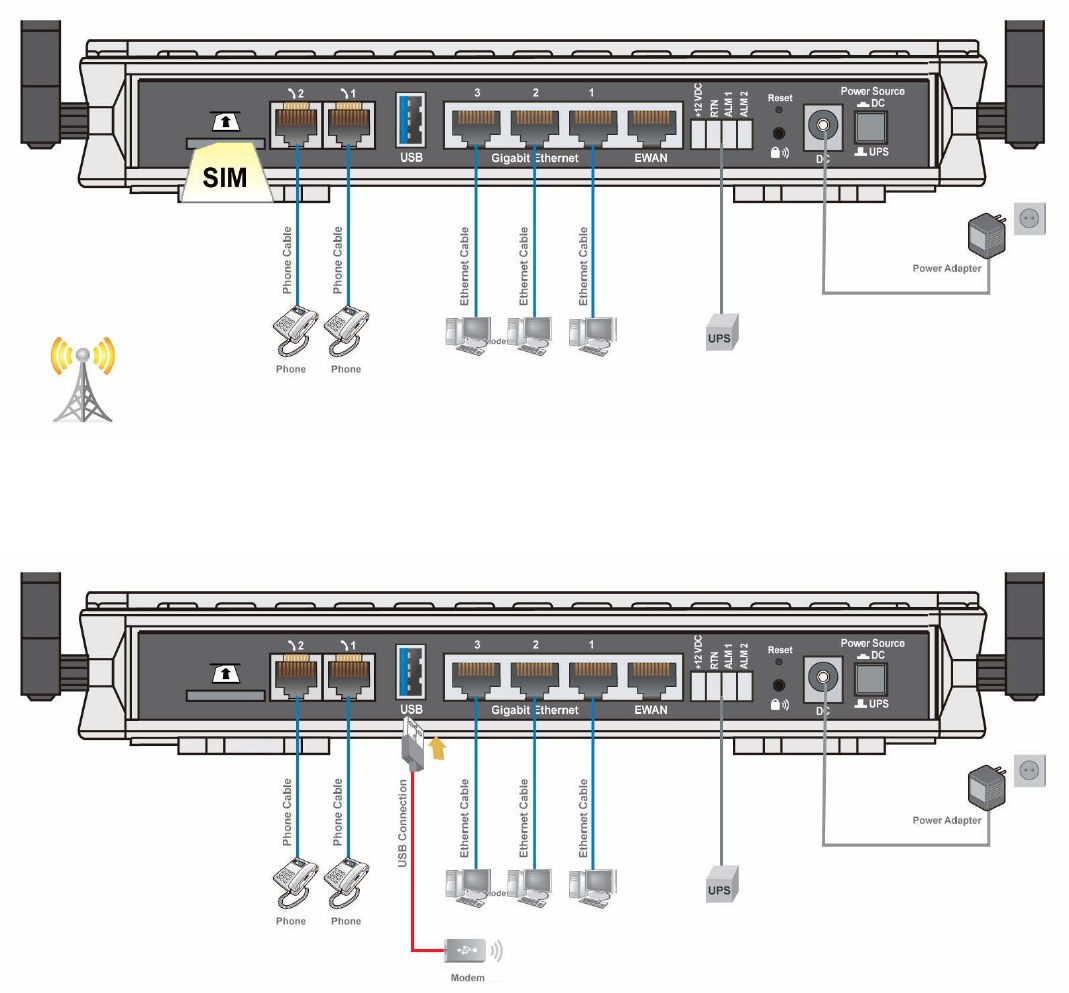
6
1.4 Applications for the BIPAC 6300VNOZ
BIPAC 6300VNOZ is an all-in-one router, supporting alternative ways (EWAN, mobile) to connect to the Internet.
Then users can choose one of the ways to connect to the Internet or ISP.
Mobile router mode
BIPAC 6300VNOZ is embedded with a module supporting mobile SIM card. It can be used to connect to high
speed mobile broadband connection.
BiPAC 6300VNOZ also supports one USB ports for your mobile dongle. It can be used to connect to high speed
mobile broadband connection, too.
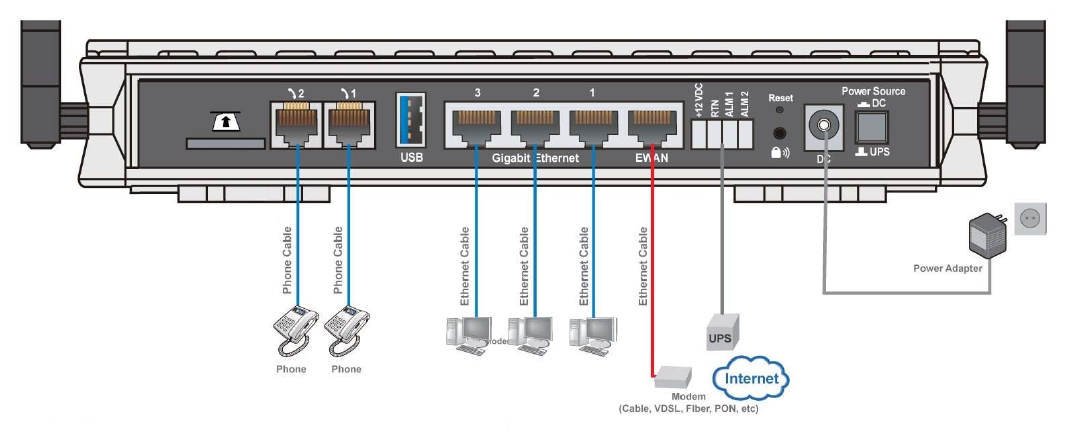
7
Broadband router mode
BIPAC 6300VNOZ has a Gigabits Ethernet WAN port to connect to your Fibre/ Cable/ xDSL modem.

7
Chapter 2
Installing the BIPAC 6300VNOZ
2.1 Important note for using the BIPAC 6300VNOZ
Place the BIPAC 6300VNOZ on a stable surface.
Only use the power adapter that comes with the package. Using a
different voltage rating power adaptor may damage the router.
Attention
Do not use the BIPAC 6300VNOZ in high humidity or high
temperatures.
Do not use the same power source for the BIPAC 6300VNOZ as
other equipment.
Do not open or repair the case yourself. If the BIPAC 6300VNOZ is
too hot, turn off the power immediately and have it repaired at a
qualified service center.
Avoid using this product and all accessories outdoors.
Warning
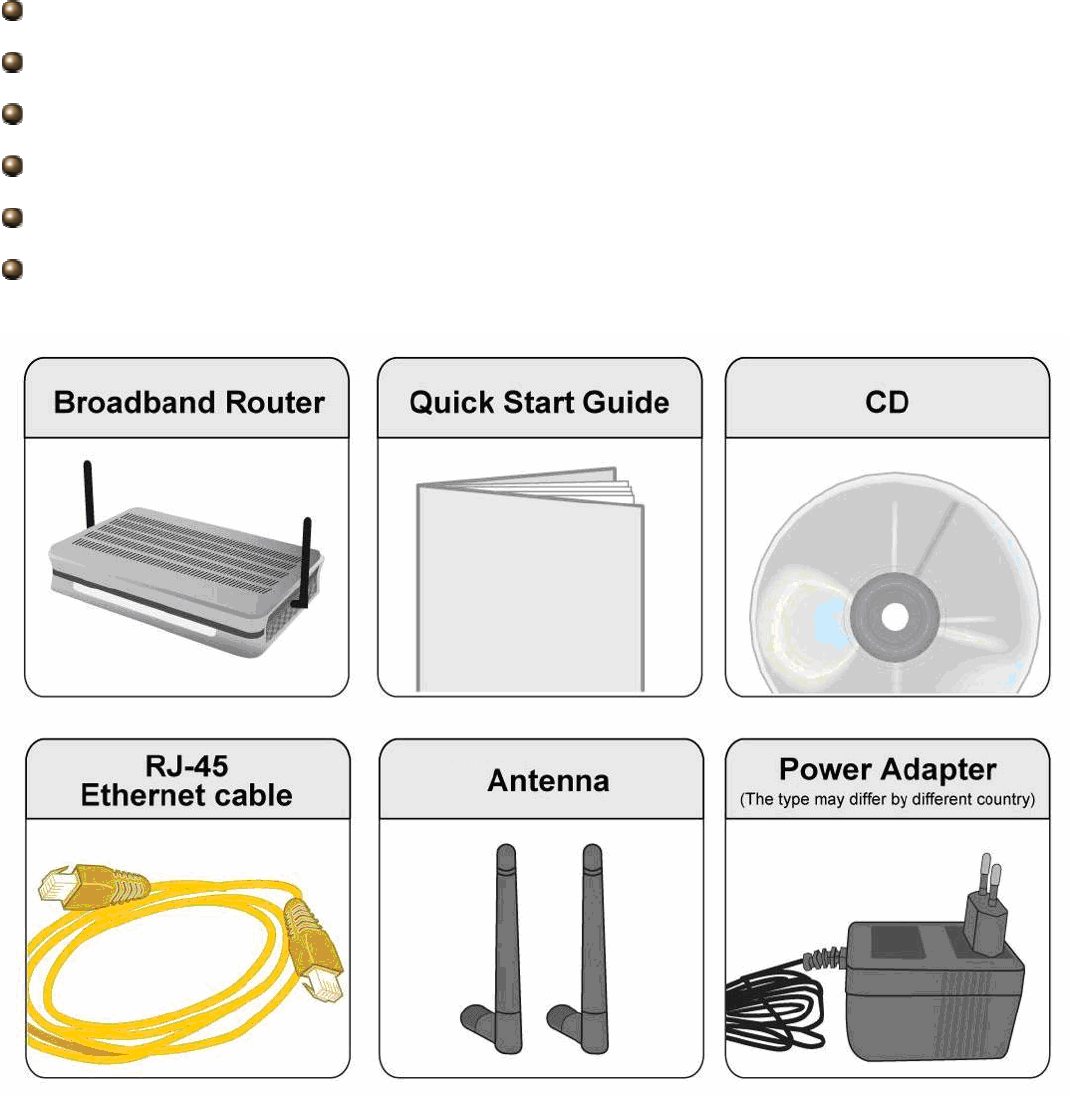
8
2.2 Package Contents
BIPAC 6300VNOZ - VoIP Wireless-N VPN Broadband Router
Quick Start Guide
CD containing user manual
Ethernet (RJ-45 CAT-5) cable
Two detachable Antennas
Power adapter

9
2.3 The Front LEDs
LED Status Meaning
Green System ready
1 Power
Red Boot failed
Green AC working and battery OK
Orange Only AC working, battery fail and has to change battery
Orange blinking AC fail and battery working
2 Battery
Off The power input is from power adapter not UPS
Green Transmission speed hitting 1000Mbps
Orange Transmission speed hitting 10/100Mbps
3 EWAN
Blinking Data being transmitted/received
Green Transmission speed hitting 1000Mbps
Orange Transmission speed hitting 10/100Mbps
4 Ethernet (1-3)
Blinking Data being transmitted/ received
5 USB Green Connected to a storage device
Green Wireless connection established
Green blinking Sending/ Receiving data
6 Wireless/ WPS
Orange WPS on
Green Successfully registered
7 Phone (1-2)
Orange Phone being in use
8 Signal Strength Green Signal strength > 75%

10
Green blinking quickly Signal strength 75% ~ 50%
Orange blinking quickly Signal strength 50% ~ 25%
Orange blinking slowly Signal strength < 25%
Orange No signal, but module OK
Off module fails or No module
Red Obtaining IP failure
Green Having obtained an IP address successfully
9 Internet
Off Router in bridged mode or WAN connection not present.
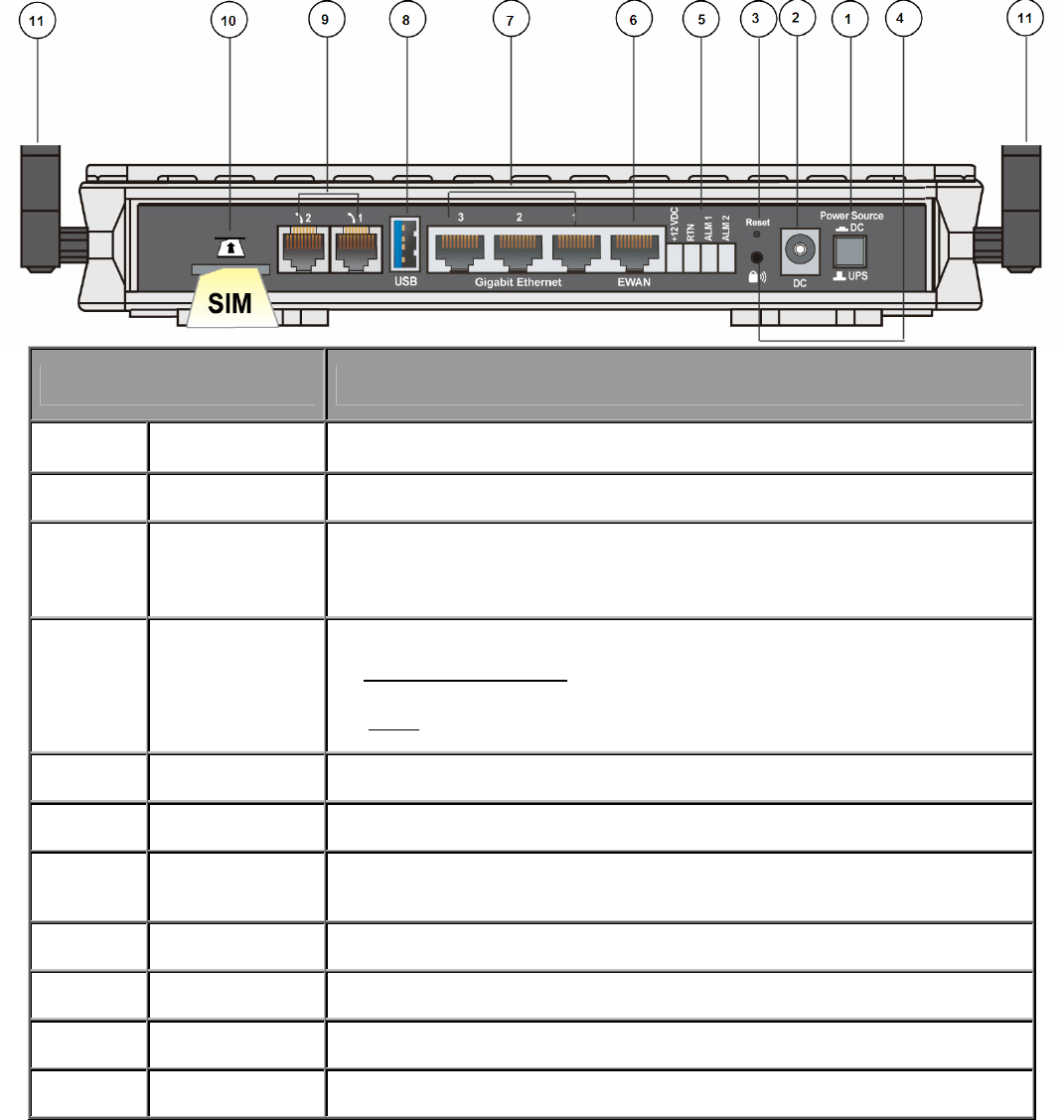
11
2.4 The Rear Ports
Port Meaning
1 Power Source
Power source selector. Switch between DC power adapter and UPS (DC).
2 DC Connect the supplied DC power adapter to this jack.
3 RESET After the device is powered on, press it 6 seconds or above: to restore to factory
default settings (this is used when you can not login to the router, e.g. forgot the
password)
4 Wireless On/Off
WPS
By controlling the pressing time, users can achieve two different effects:
(1) Wireless ON/OFF button: Press over 6 seconds to switch on wireless function when
wireless is off and press over 6 seconds again to disable wireless function.
(2) WPS: Press less than 6 seconds to trigger WPS function.
5 UPS Connect the supplied standardized UPS(DC) to this jack
6 EWAN Connect to Fiber/ Cable/ xDSL Modem with your RJ-45 cable.
7 Gigabit Ethernet
Connect a UTP Ethernet cable (Cat-5 or Cat-5e) to one of the three LAN ports when
connecting to a PC or an office/home network of 10Mbps /100Mbps /1000Mbps.
8 USB Connect the storage device to this port.
9 Phone (1-2) Connect your analog phone set to this port with the RJ-11 cable.
10 SIM Card slot Plug the proper mini SIM card(2FF) into the slot
11 Antenna Connect to the supplied two high performance external antennas
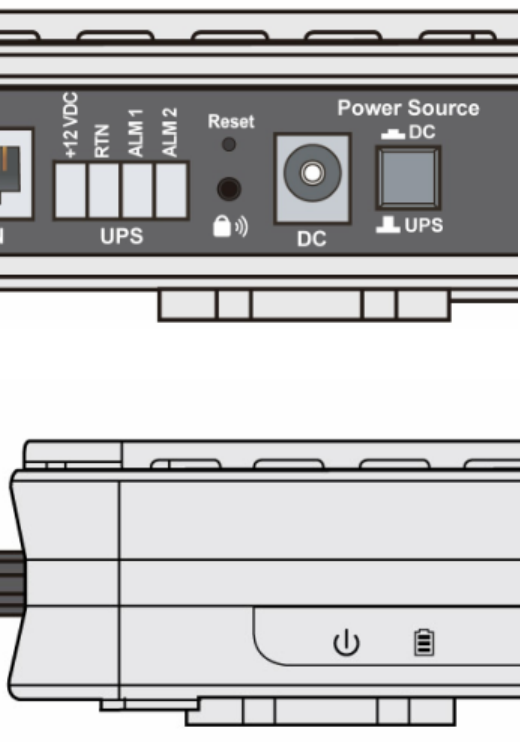
12
2.5 Power Source
6300VNOZ offers two kinds of power input, namely, DC power Adapter and DC UPS (or BBU).
6300VNOZ can take the advantage of UPS (Uninterruptible Power Supply) to keep working even if the power
outage hit your router when the router in working in DC UPS mode.
(a picture of the rear focusing on the power source)
(a shot from the front panel, with second icon being identified as the Battery LED)
How to switch between the two power input:
Press down "Power Source" push button, the power source is "DC" power adapter.
Press up "Power Source" push button, the power source is UPS. Device can continue to operate for a period of
time after AC power failure, due to uninterrupted power system features of UPS.(Note: a standardized DC UPS
will come to your by BEC, customers should not turn to other substandard DC UPS.)
UPS feature:
A battery LED is shown on your device front panel to indicate the DC UPS use. The battery LED is on only when
DC UPS is in use, and when the device is operating using DC power adapter, the LED unlit.
13
The meanings of the different status of Battery LED:
Green lit: AC is working, UPS battery working well
Orange Lit: Only AC is working, but Battery fails. And you have to change battery
Orange Blinking: AC fails, but battery is working
14
2.6 Cabling
One of the most common causes of problems is bad cabling. Make sure that all connected devices are turned
on. On the front panel of the product is a bank of LEDs. Verify that the LAN Link and LEDs are lit. If they are not,
verify that you are using the proper cables.
Make sure that all other devices (e.g. telephones, fax machines, analogue modems) connected to the same
telephone line as your Billion router have a line filter connected between them and the wall socket (unless you
are using a Central Splitter or Central Filter installed by a qualified and licensed electrician), and that all line
filters are correctly installed in a right way. If the line filter is not correctly installed and connected, it may cause
problems to your connection or may result in frequent disconnections.
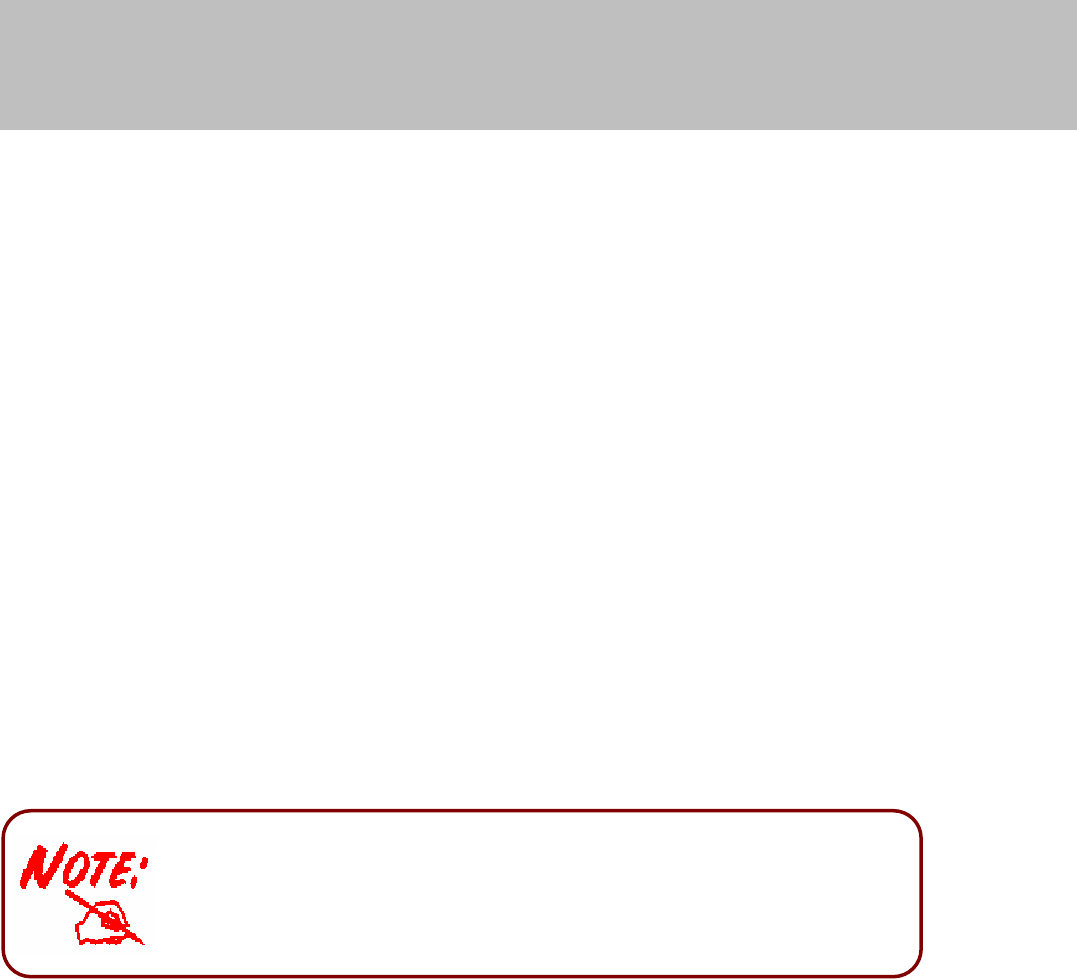
15
Chapter 3
Basic Installation
The router can be configured with your web browser. A web browser is included as a standard application in the
following operating systems: Windows 98/NT/2000/XP/Vista/Win7, Linux, Mac OS, etc. The product provides
an easy and user-friendly interface for configuration.
3.1 Before Configuration
PCs must have an Ethernet interface installed properly and be connected to the router either directly or through
an external repeater hub, and have TCP/IP installed and configured to obtain an IP address through a DHCP
server or a fixed IP address that must be in the same subnet as the router. The default IP address of the router
is 192.168.1.254 and the subnet mask is 255.255.255.0 (i.e. any attached PC must be in the same subnet, and
have an IP address in the range of 192.168.1.1 to 192.168.1.253). The best and easiest way is to configure the
PC to get an IP address automatically from the router using DHCP. If you encounter any problems accessing the
router’s web interface it may also be advisable to uninstall any kind of software firewall on your PCs, as they
can cause problems accessing the 192.168.1.254 IP address of the router. Users should make their own
decisions on how to best protect their network.
Please follow the steps below for your PC’s network environment installation. First of all, please check your PC’s
network components. The TCP/IP protocol stack and Ethernet network adapter must be installed. If not, please
refer to your Windows-related or other operating system manuals.
Any TCP/IP capable workstation can be used to communicate with or
through the BIPAC 6300VNOZ. To configure other types of workstations,
please consult the manufacturer’s documentation.
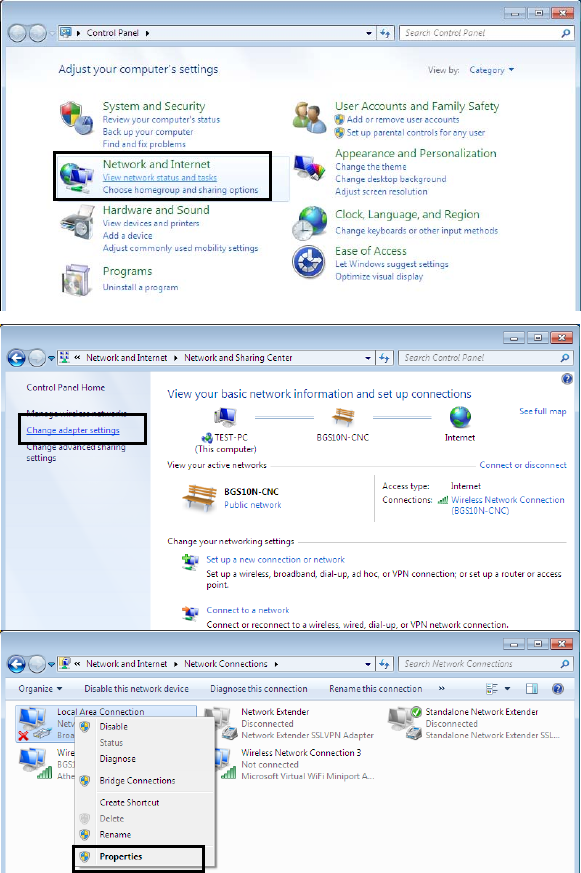
16
3.1.1 Configuring a PC in Windows 7
1. Go to Start. Click on Control
Panel. Then click on Network
and Internet.
2. When the Network and
Sharing Center window pops
up, select and click on Change
adapter settings on the left
window panel.
3. Select the Local Area
Connection, and right click the
icon to select Properties.
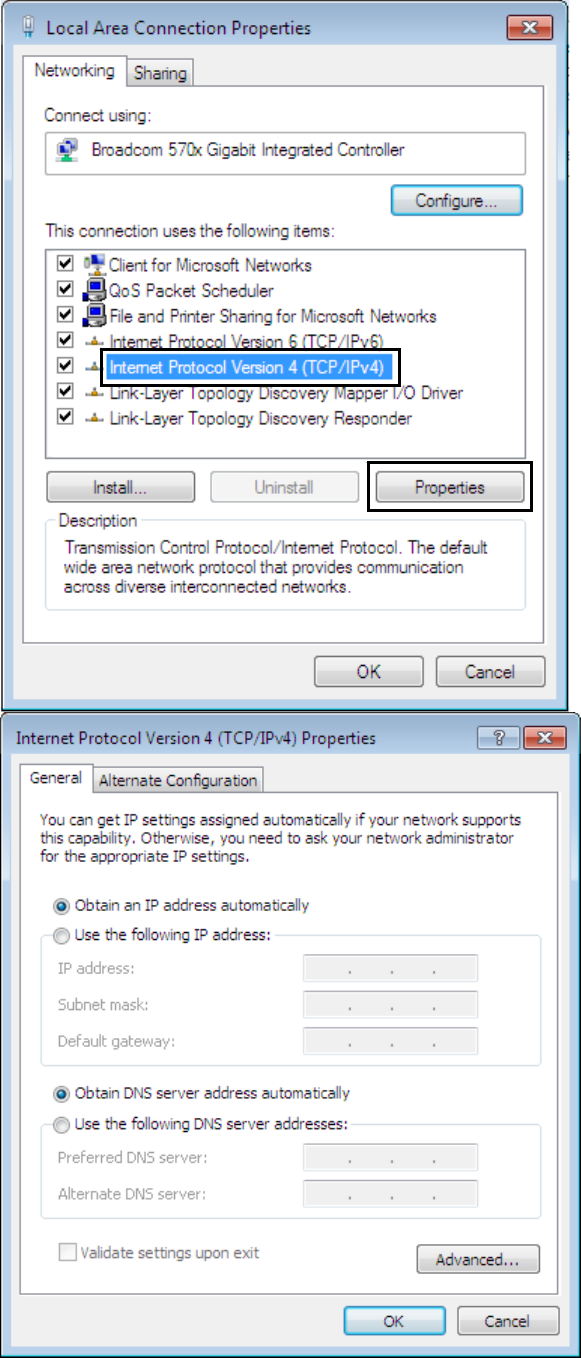
17
IPv4:
4. Select Internet Protocol
Version 4 (TCP/IPv4) then
click Properties
5. In the TCP/IPv4 properties
window, select the Obtain an IP
address automatically and
Obtain DNS Server address
automatically radio buttons.
Then click OK to exit the
setting.
6. Click OK again in the Local
Area Connection Properties
window to apply the new
configuration.
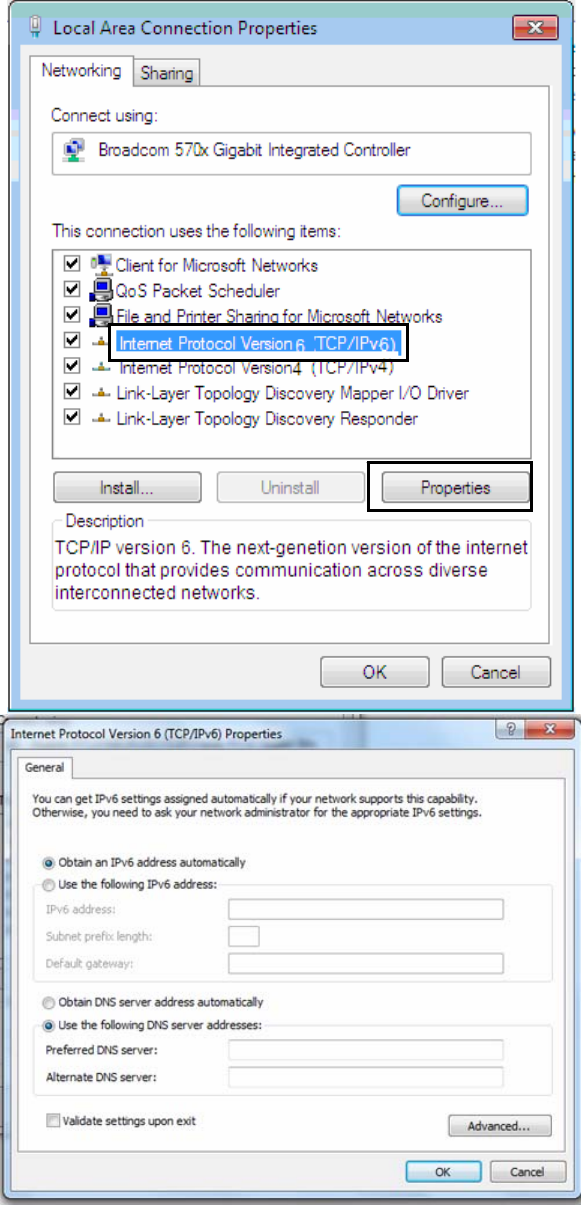
18
IPv6:
4. Select Internet Protocol
Version 6 (TCP/IPv6) then
click Properties
5. In the TCP/IPv6 properties
window, select the Obtain an
IPv6 address automatically
and Obtain DNS Server
address automatically radio
buttons. Then click OK to exit
the setting.
6. Click OK again in the Local
Area Connection Properties
window to apply the new
configuration.
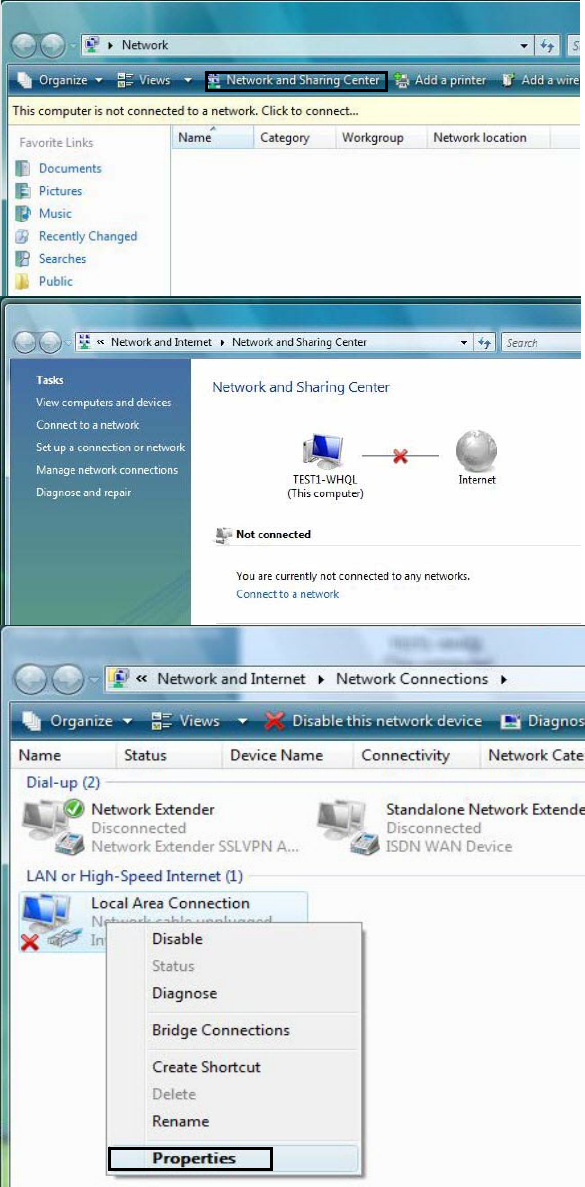
19
3.1.2 Configuring a PC in Windows Vista
1. Go to Start. Click on Network.
Then click on Network and
Sharing Center at the top bar.
2. When the Network and
Sharing Center window pops
up, select and click on Manage
network connections on the
left window pane.
3. Select the Local Area
Connection, and right click the
icon to select Properties.

20
IPv4:
4. Select Internet Protocol
Version 4 (TCP/IPv4) then click
Properties.
5. In the TCP/IPv4 properties
window, select the Obtain an IP
address automatically and
Obtain DNS Server address
automatically radio buttons.
Then click OK to exit the setting.
6. Click OK again in the Local
Area Connection Properties
window to apply the new
configuration.
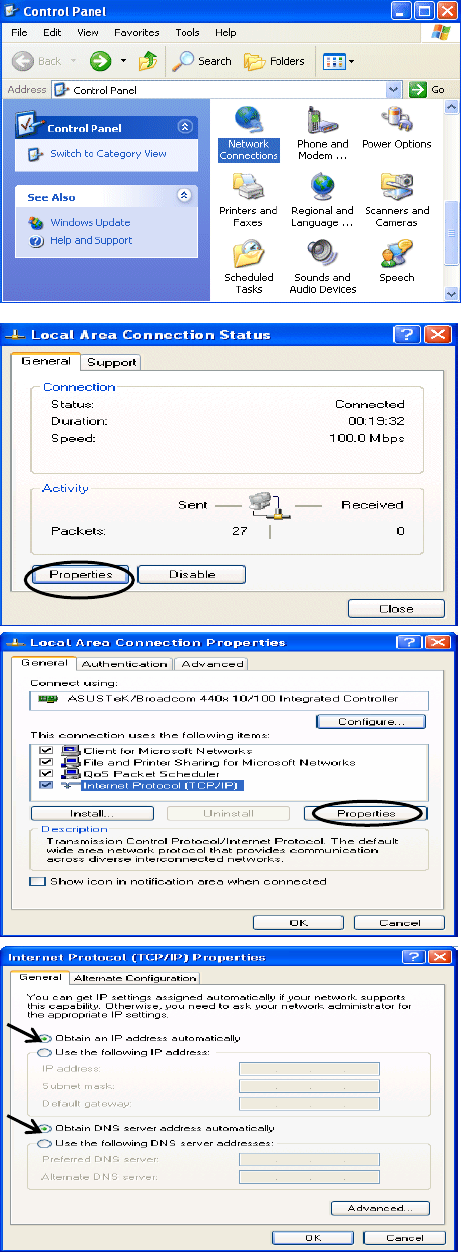
21
3.1.3 Configuring a PC in Windows XP
IPv4:
1. Go to Start / Control Panel (in Classic
View). In the Control Panel, double-click on
Network Connections
2. Double-click Local Area Connection.
3. In the Local Area Connection Status
window, click Properties.
4. Select Internet Protocol (TCP/IP) and click
Properties.
5. Select the Obtain an IP address
automatically and the Obtain DNS server
address automatically radio buttons.
6. Click OK to finish the configuration.
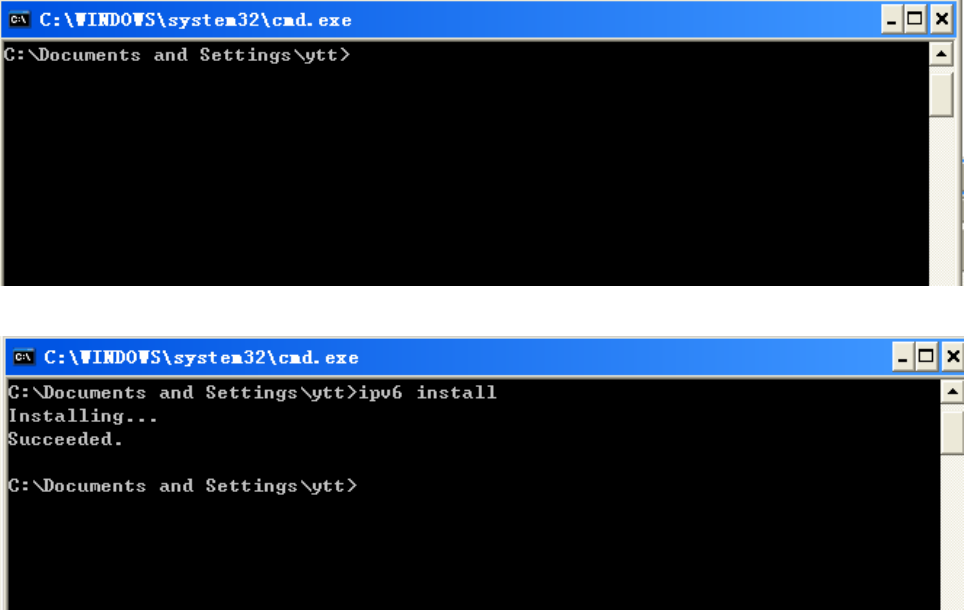
22
IPv6:
IPv6 is supported by Windows XP, but you should install it first.
Act as shown below:
1. On the desktop, Click Start > Run, type cmd, then press Enter key in the keyboard, the following screen
appears.
2. Key in command ipv6 install
Configuration is OK now, you can test whether it works ok.
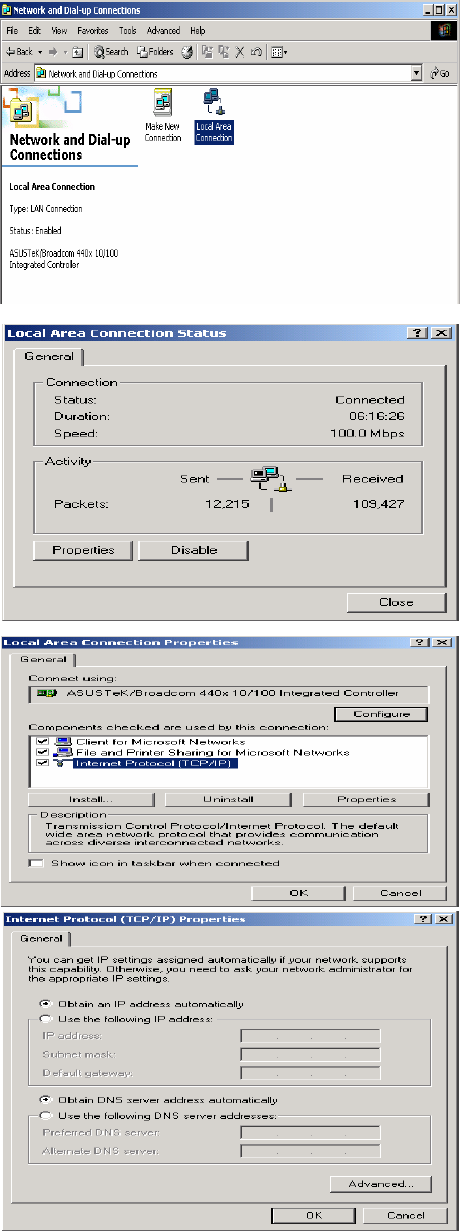
23
3.1.4 Configuring a PC in Windows 2000
1. Go to Start / Settings / Control Panel. In
the Control Panel, double-click on Network
and Dial-up Connections.
2. Double-click Local Area Connection.
3. In the Local Area Connection Status
window click Properties.
4. Select Internet Protocol (TCP/IP) and click
Properties.
5. Select the Obtain an IP address
automatically and the Obtain DNS server
address automatically radio buttons.
6. Click OK to finish the configuration.
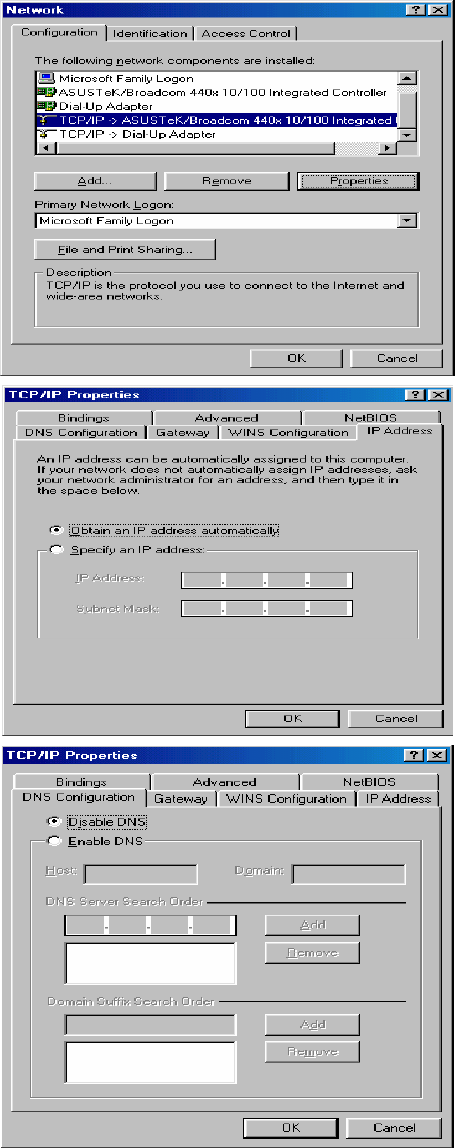
24
3.1.5 Configuring a PC in Windows 98/Me
1. Go to Start / Settings / Control Panel. In
the Control Panel, double-click on Network
and choose the Configuration tab.
2. Select TCP/IP ->NE2000 Compatible, or
the name of your Network Interface Card
(NIC) in your PC.
3. Select the Obtain an IP address
automatically radio button.
4. Then select the DNS Configuration tab.
5. Select the Disable DNS radio button and
click OK to finish the configuration.
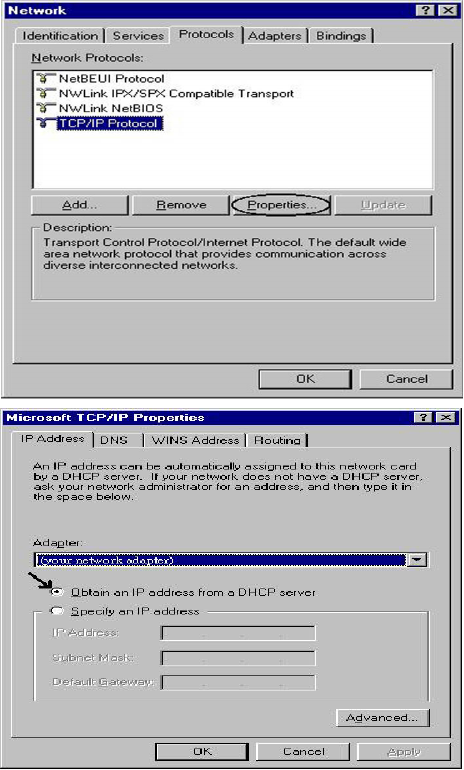
25
3.1.6 Configuring a PC in Windows NT4.0
1. Go to Start / Settings / Control Panel. In
the Control Panel, double-click on
Network and choose the Protocols tab.
2. Select TCP/IP Protocol and click
Properties.
3. Select the Obtain an IP address from a
DHCP server radio button and click OK.
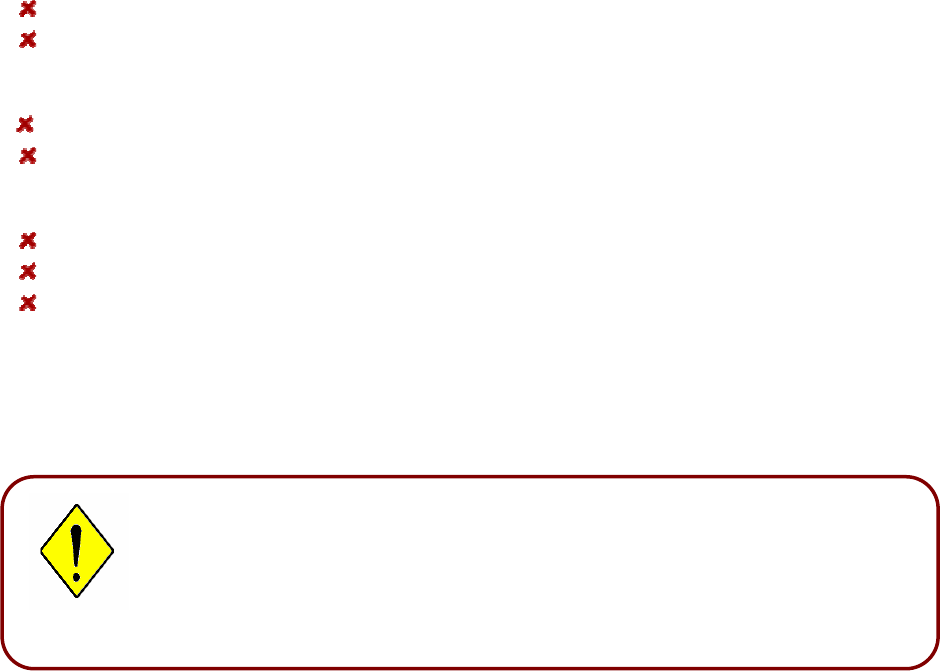
26
3.2 Factory Default Settings
Before configuring your router, you need to know the following default settings.
Web Interface:
Username: admin
Password: admin
LAN Device IP Settings:
IP Address: 192.168.1.254
Subnet Mask: 255.255.255.0
DHCP server:
DHCP server is enabled.
Start IP Address: 192.168.1.100
IP pool counts: 20
3.2.1 Username and Password
The default username and password are “admin” and “admin” respectively.
Attention
Attention
If you ever forget the password to log in, you may press the RESET button
up to 6 seconds to restore the factory default settings.
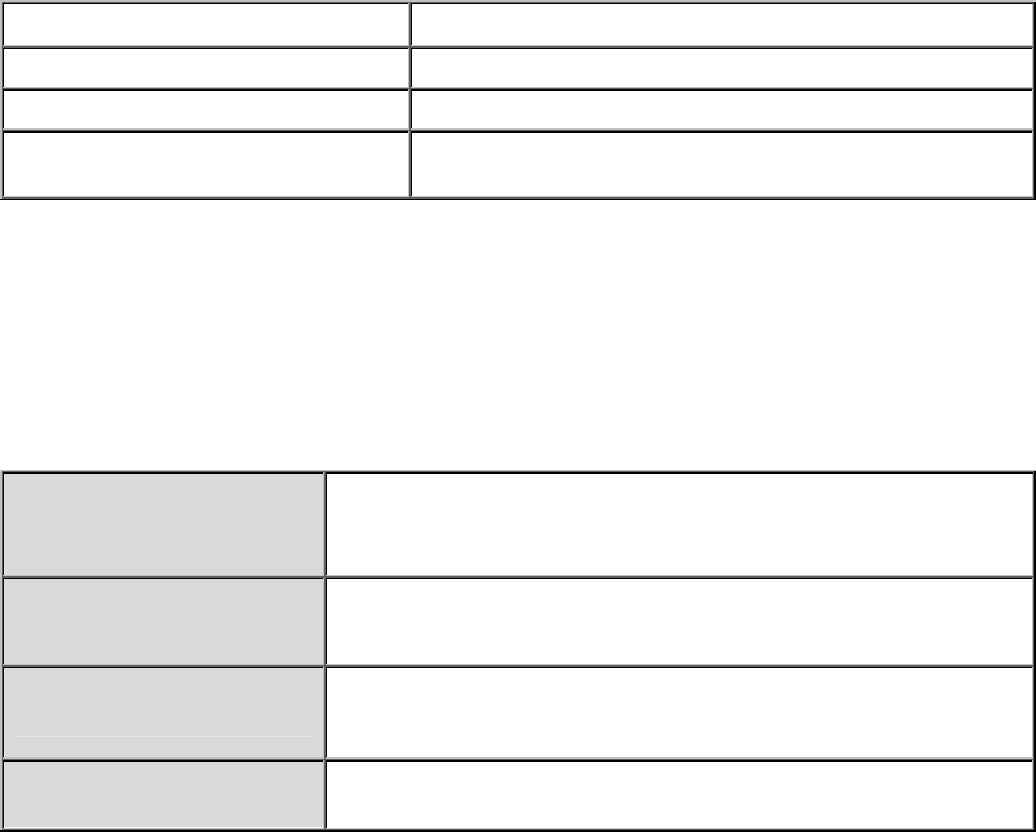
27
3.3 LAN Port Addresses
The parameters of LAN ports are pre-set in the factory. The default values are shown below.
IPv4:
IP address 192.168.1.254
Subnet Mask 255.255.255.0
DHCP server function Enabled
IP addresses for distribution to PCs 100 IP addresses continuing from 192.168.1.100 through
192.168.1.199
3.4 Information from your ISP
Before configuring this device, you have to check with your ISP (Internet Service Provider) what kind of service
is provided such as EWAN ((Dynamic IP address, Static IP address, PPPoE, Bridge Mode).
Gather the information as illustrated in the following table and keep it for reference.
EWAN:
PPPoE Username, Password, Service Name, and Domain Name System (DNS) IP
address (it can be automatically assigned by your ISP when you connect or be
set manually).
Dynamic IP Address Domain Name System (DNS) IP address (it can be automatically assigned by
your ISP when you connect or be set manually).
Static IP Address Static IP Address, IP Subnet Mask, Gateway IP Address, and Domain Name
System (DNS) IP address.
Bridge Mode Pure bridge.
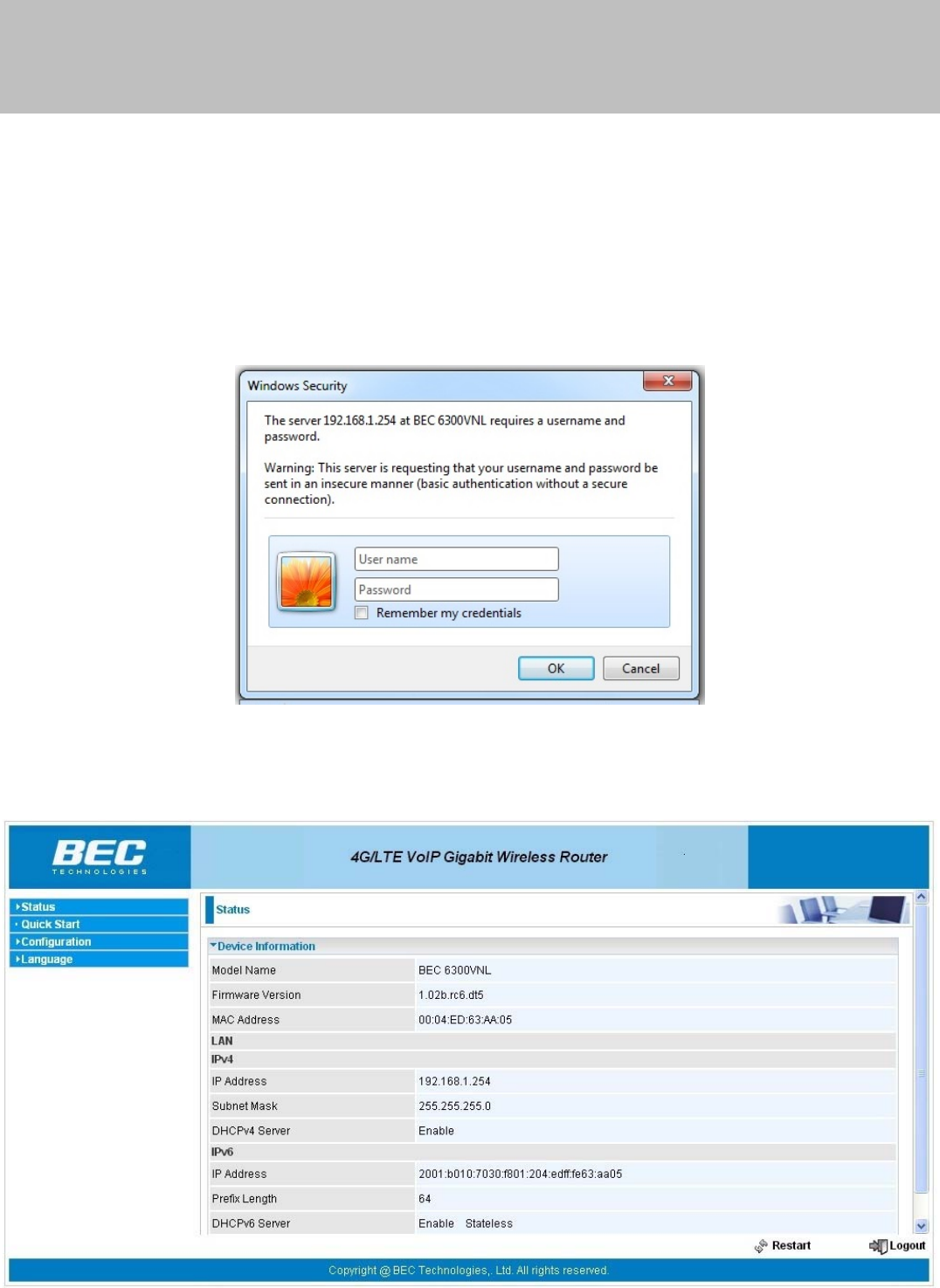
28
Chapter 4
Configuration
4.1 Configuring BIPAC 6300VNOZ with your Web Browser
Open your web browser, enter the IP address of your router, which by default is 192.168.1.254, and click “OK”,
a user name and password window prompt will appear. The default username and password are “admin” and
“admin”.
Congratulation! You are now successfully logged on to the BIPAC 6300VNOZ!

29
At the configuration homepage, the left navigation pane where bookmarks are provided links you directly to the
desired setup page, including:
Status(Device Info, System Log, Statistics, DHCP Table, Disk Status, VoIP Status)
Quick Start (Wizard Setup)
Configuration (Interface Setup, Advanced Setup, VoIP, Access Management, Maintenance)
Language
Please see the relevant sections of this manual for detailed instructions on how to configure your router.
30
4.2 Status
In this section, you can check the router working status, including Device Info, System Log, Statistics, DHCP
Table, Disk Status, and VoIP Status.
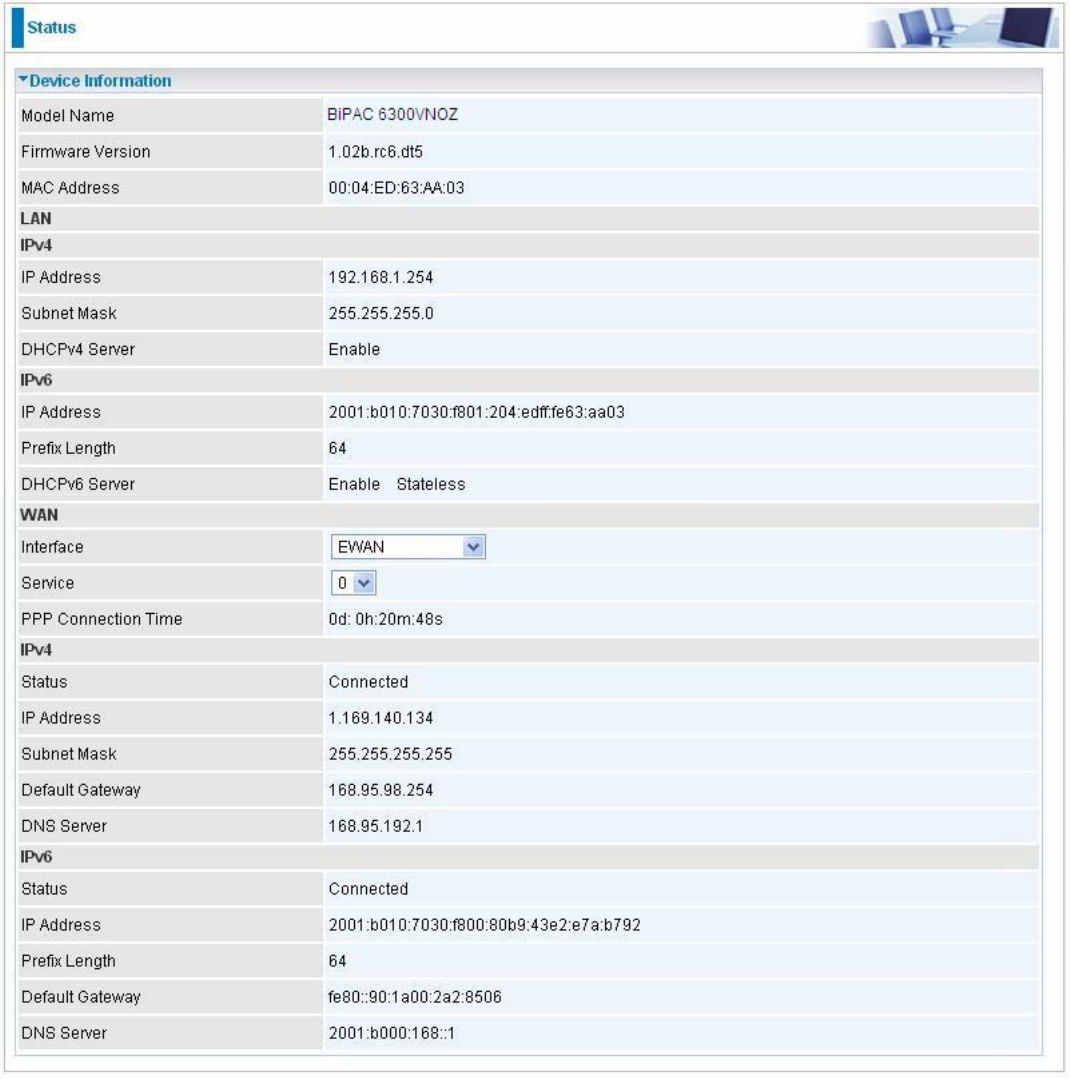
31
4.2.1 Device Info
Users will see device's basic information in this page.
EWAN

32
Device Information
Model Name: Show model name of the router
Firmware Version: This is the Firmware version
MAC Address: This is the MAC Address
LAN
IPv4:
IP Address: LAN port IPv4 address.
Subnet Mask: LAN port IP subnet mask.
DHCPv4 Server: LAN port DHCP role - Enabled, Relay or Disabled.
IPv6:
IP Address: LAN port IPv6 address.
Prefix Length: The prefix length
DHCPv6 Server: The DHCP status.
WAN
Interface: The now used connection method, "EWAN".
Service: The WAN interface service index.
PPP Connection Time: The time totaled since PPP has been successfully connected.
IPv4:
Status: The connection status, Not connected or Connected.
IP Address: WAN port IP address.
Subnet Mask: WAN port IP subnet mask.
Default Gateway: The IP address of the default gateway.
DNS Server: DNS information.
IPv6:
Status: The IPv6 connection status.
IP Address: WAN port IPv6 address.
Prefix Length: The prefix length of IPv6 address.
Default Gateway: The IP address of the default gateway.
DNS Server: DNS information.
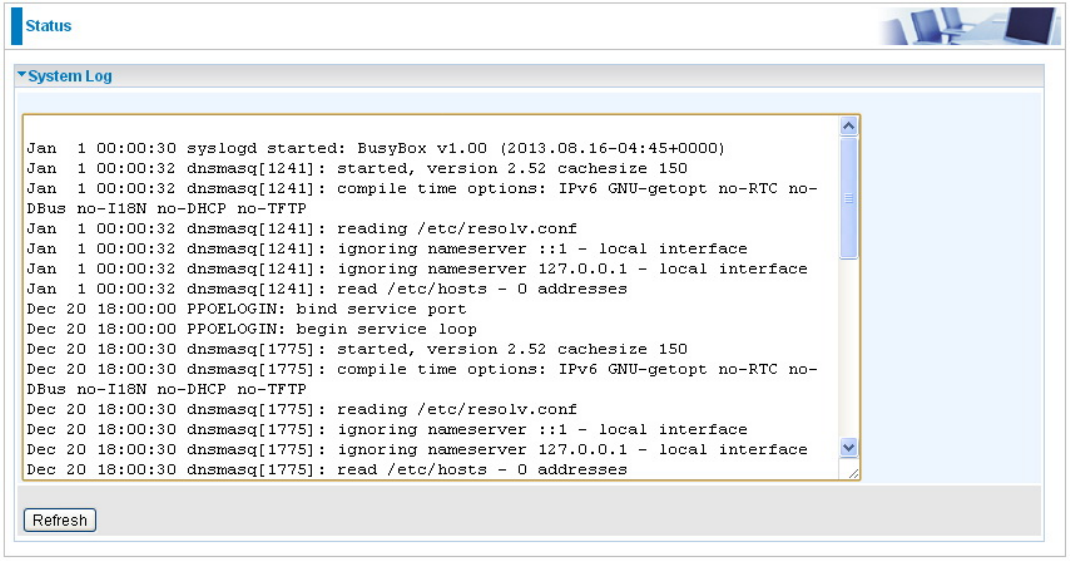
33
4.2.2 System Log
In system log, users can check the operations to the router and track the glitches to the router when occurred.
Refresh: Press this button to refresh the statistics.

34
4.2.3 Statistics
Ethernet
Interface: This field displays the type of port
Transmit Frames: This field displays the number of frames transmitted until the latest second.
Transmit Multicast Frames: This field displays the number of multicast frames transmitted until the latest
second.
Transmit Total Bytes: This field displays the number of bytes transmitted until the latest second.
Transmit Collision: This is the number of collisions on this port.
Transmit Error Frames: This field displays the number of error packets on this port.
Receive Frames: This field displays the number of frames received until the latest second.
Receive Multicast Frames: This field displays the number of multicast frames received until the latest second.
Receive Total Bytes: This field displays the number of bytes received until the latest second.
Receive CRC Errors: This field displays the number of error packets on this port.
Receive Under-size Frames: This field displays the number of under-size frames received until the latest
second.
Refresh: Press this button to refresh the statistics.
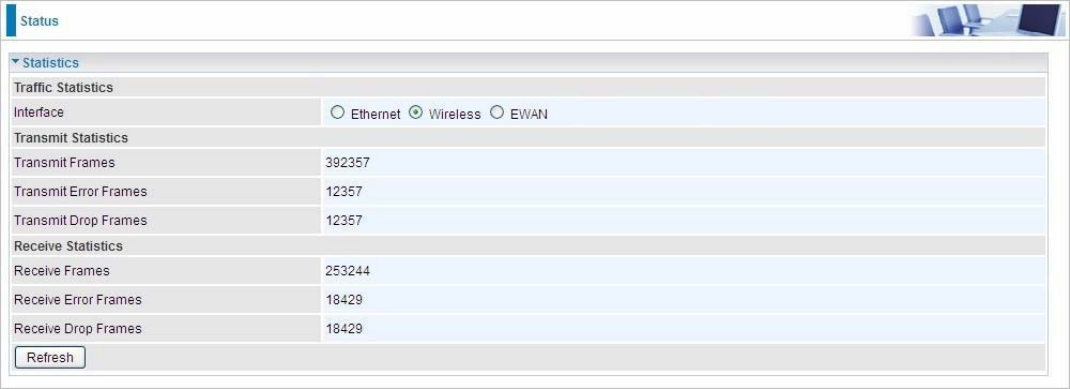
35
Wireless
Transmit Frames: This field displays the number of frames transmitted until the latest second.
Transmit Error Frames: This field displays the number of error frames transmitted until the latest second.
Transmit Drop Frames: This field displays the number of drop frames transmitted until the latest second.
Receive Frames: This field displays the number of frames received until the latest second.
Receive Error Frames: This field displays the number of error frames received until the latest second.
Receive Drop Frames: This field displays the number of drop frames received until the latest second.
Refresh: Press this button to refresh the statistics.
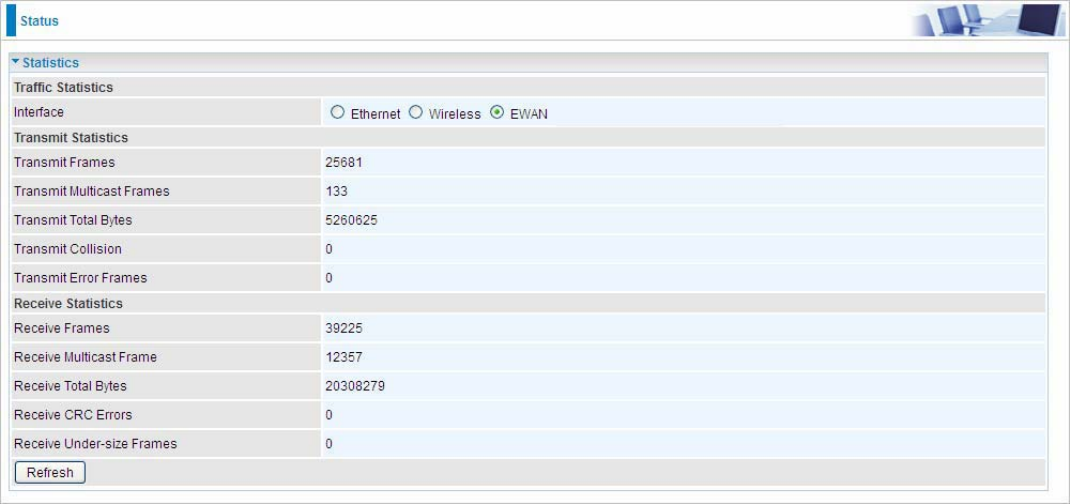
36
EWAN
Transmit Frames: This field displays the total number of frames transmitted until the latest second.
Transmit Multicast Frames: This field displays the total number of multicast frames transmitted till the latest
second.
Transmit Total Bytes: This field displays the total number of bytes transmitted until the latest second.
Transmit Collision: This is the number of collisions on this port.
Transmit Error Frames: This field displays the number of error packets on this port.
Receive Frames: This field displays the number of frames received until the latest second.
Receive Multicast Frames: This field displays the number of multicast frames received until the latest second.
Receive Total Bytes: This field displays the number of bytes received until the latest second.
Receive CRC Errors: This field displays the number of error packets on this port.
Receive Under-size Frames: This field displays the number of under-size frames received until the latest
second.
Refresh: Press this button to refresh the statistics.

37
4.2.4 DHCP Table
DHCP table displays the devices connected to the router with clear information.
#: The index identifying the connected devices.
Host Name: Show the hostname of the PC.
IP Address: The IP allocated to the device.
MAC Address: The MAC of the connected device.
Expire Time: The total remaining interval since the IP assignment to the PC.

38
4.2.5 Disk Status
Partition: Display the USB storage partition.
Disk Space(KB): Display the total storage space of the NAS in KBytes unit.
Free Space(KB): Display the available space in KBytes unit.

39
4.2.6 VoIP Status
4.2.6.1 VoIP Status
VoIP status give users a directive picture on the registered VoIP accounts.
Phone Number: The phone number user registers and fills in the Basic page of VoIP.
Host: Show the IP address and port number of SIP Registrar.
Status: The status of the registered SIP account.
Registered Time: The duration the account has been successfully registered to the SIP registrar.
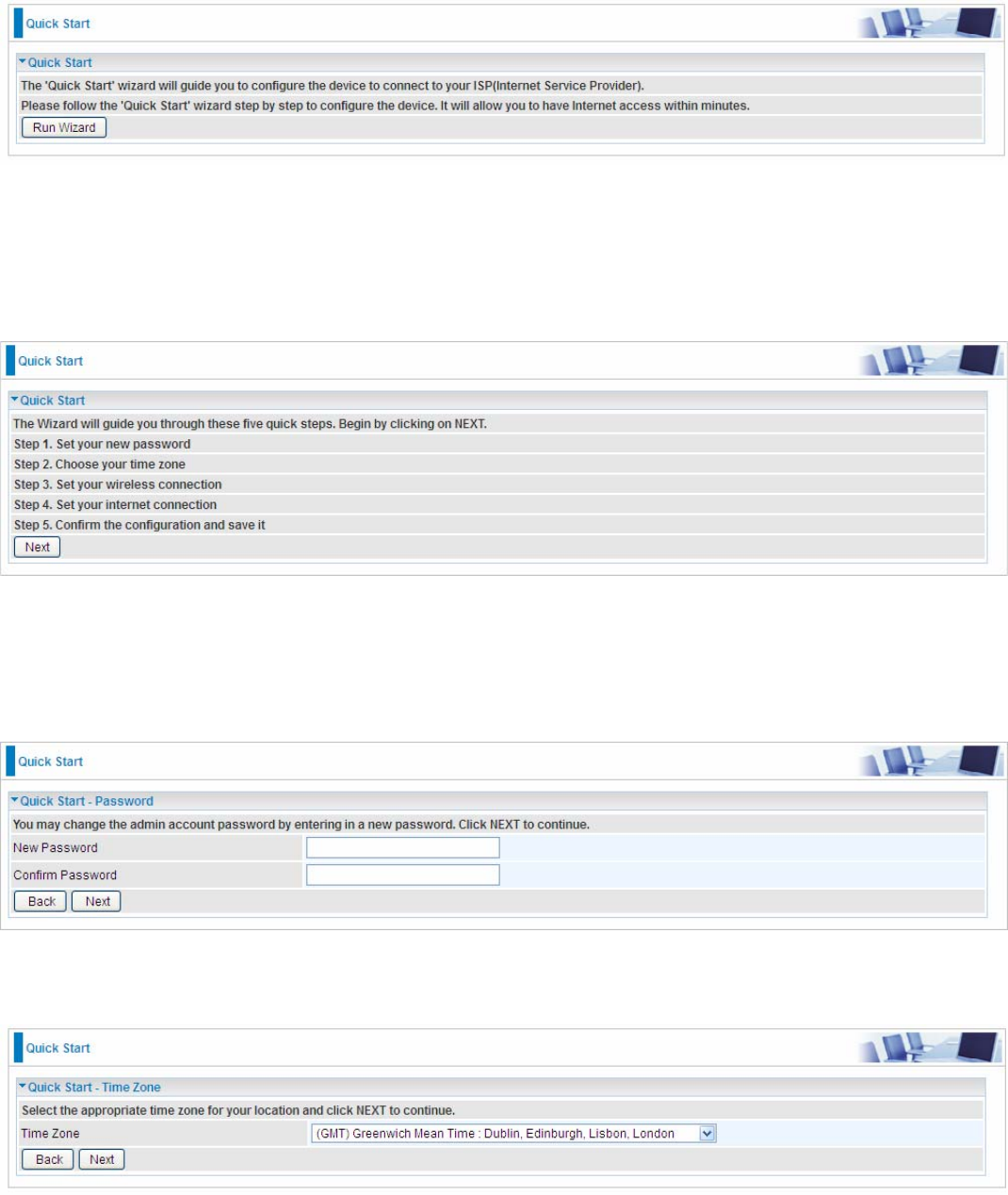
40
4.3 Quick Start
For detailed instructions on configuring WAN settings, see the Interface Setup section of this manual.
The Quick Start Wizard is a useful and easy utility to help setup the device to quickly connect to your ISP
(Internet Service Provider) with only a few steps required. It will guide you step by step to configure the
password, time zone, and WAN settings of your device. The Quick Start Wizard is a helpful guide for first time
users to the device.
Click NEXT to enter step 1.
Step1. Set new password of the “admin” account. The password was used to manage the web access. The
default is “admin”. Once changed, please remember carefully. Click NEXT to continue.
Step2: Choose your time zone. Click NEXT to continue.

41
Step3: Set your wireless connection. Click NEXT to continue.
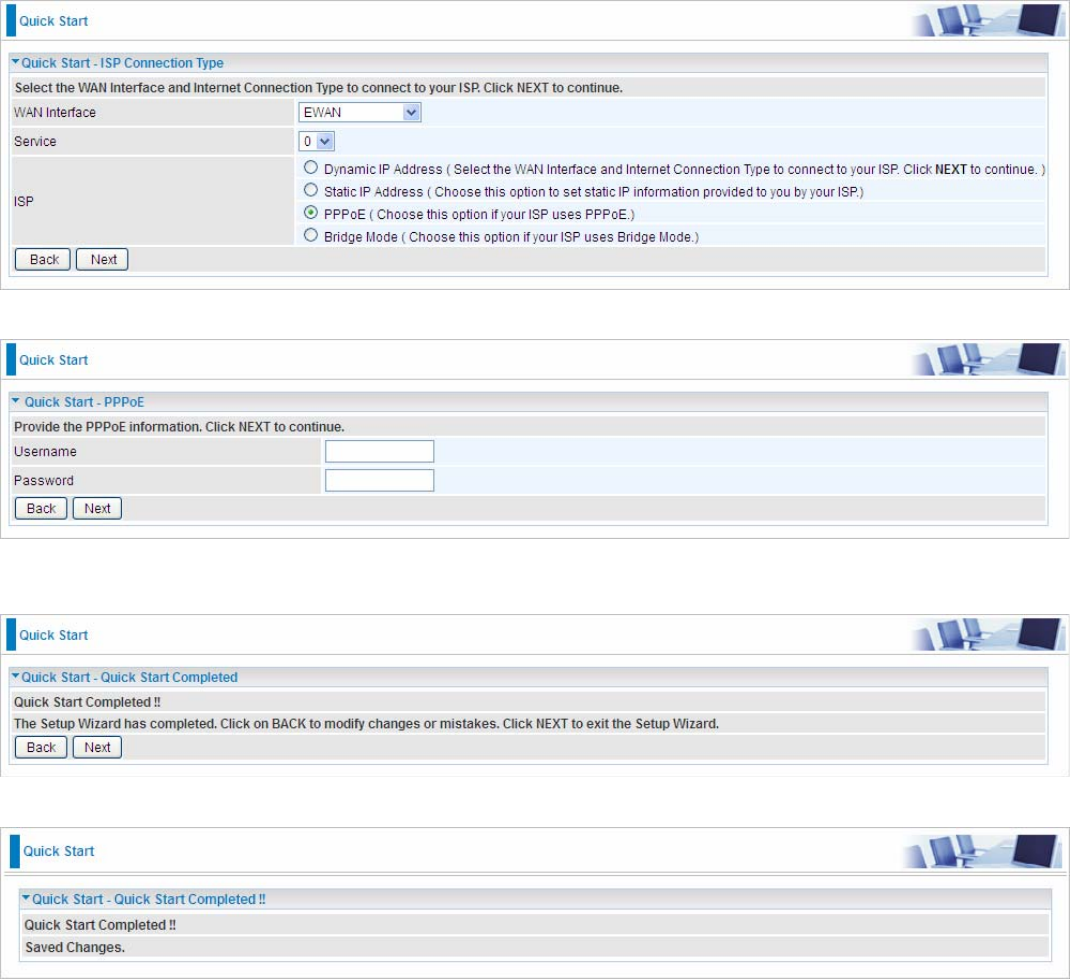
42
Step4: Set your Internet connection
WAN Transfer Modes: EWAN
EWAN
1). Select EWAN. Refer to your ISP to choose the appropriate connection protocol. Click NEXT to continue.
2). Enter the PPPoE account information provided to you by your ISP. Click NEXT to continue.
3).The Setup Wizard has completed. Click on BACK to modify changes or mistakes. Click NEXT to save the
current settings.
4). Quick Start Completed!
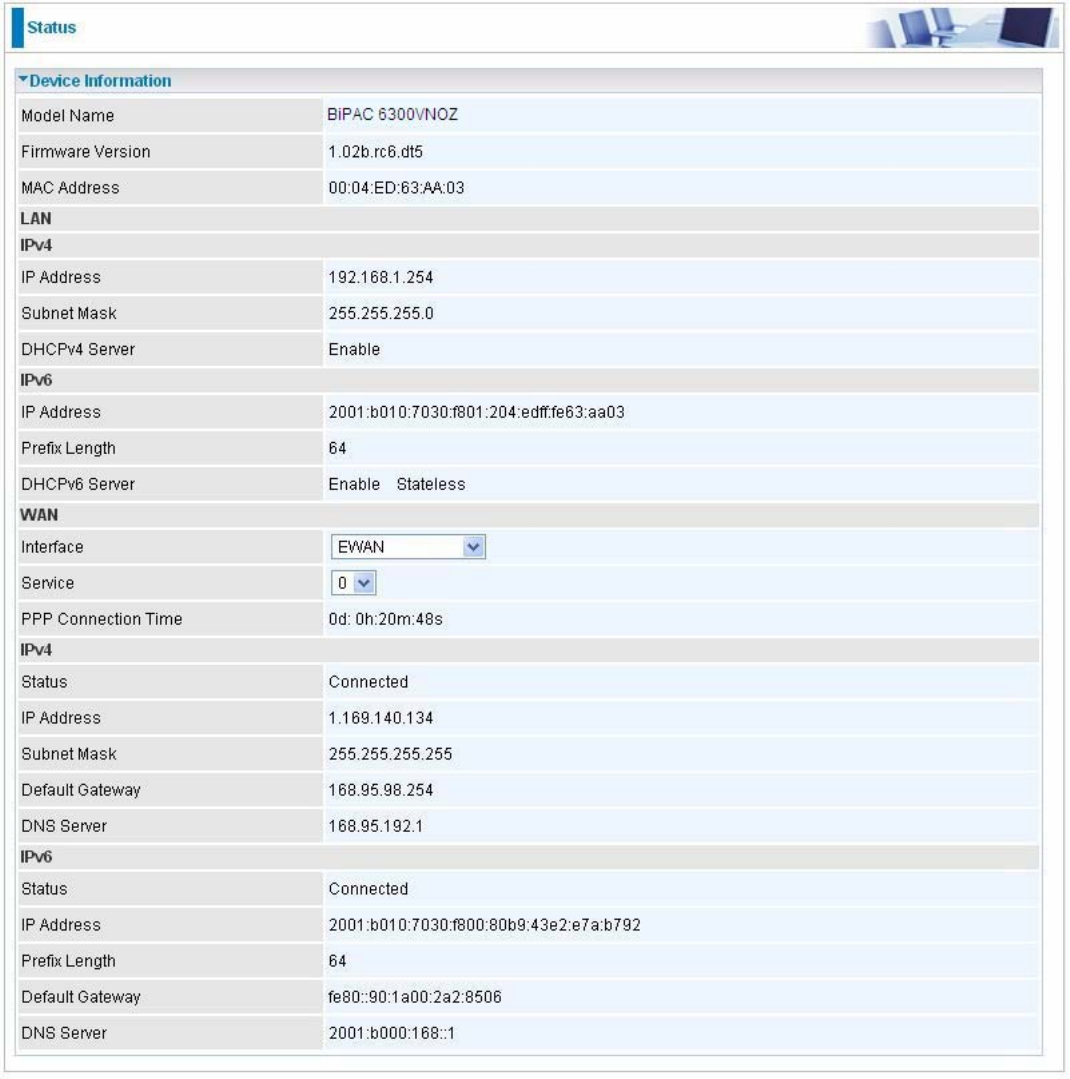
43
Switch to Status > Device Info to view the status.
44
4.4 Configuration
Click this item to access the following sub-items that configure the router: Interface Setup, Advanced Setup,
VoIP, Access Management, and Maintenance.
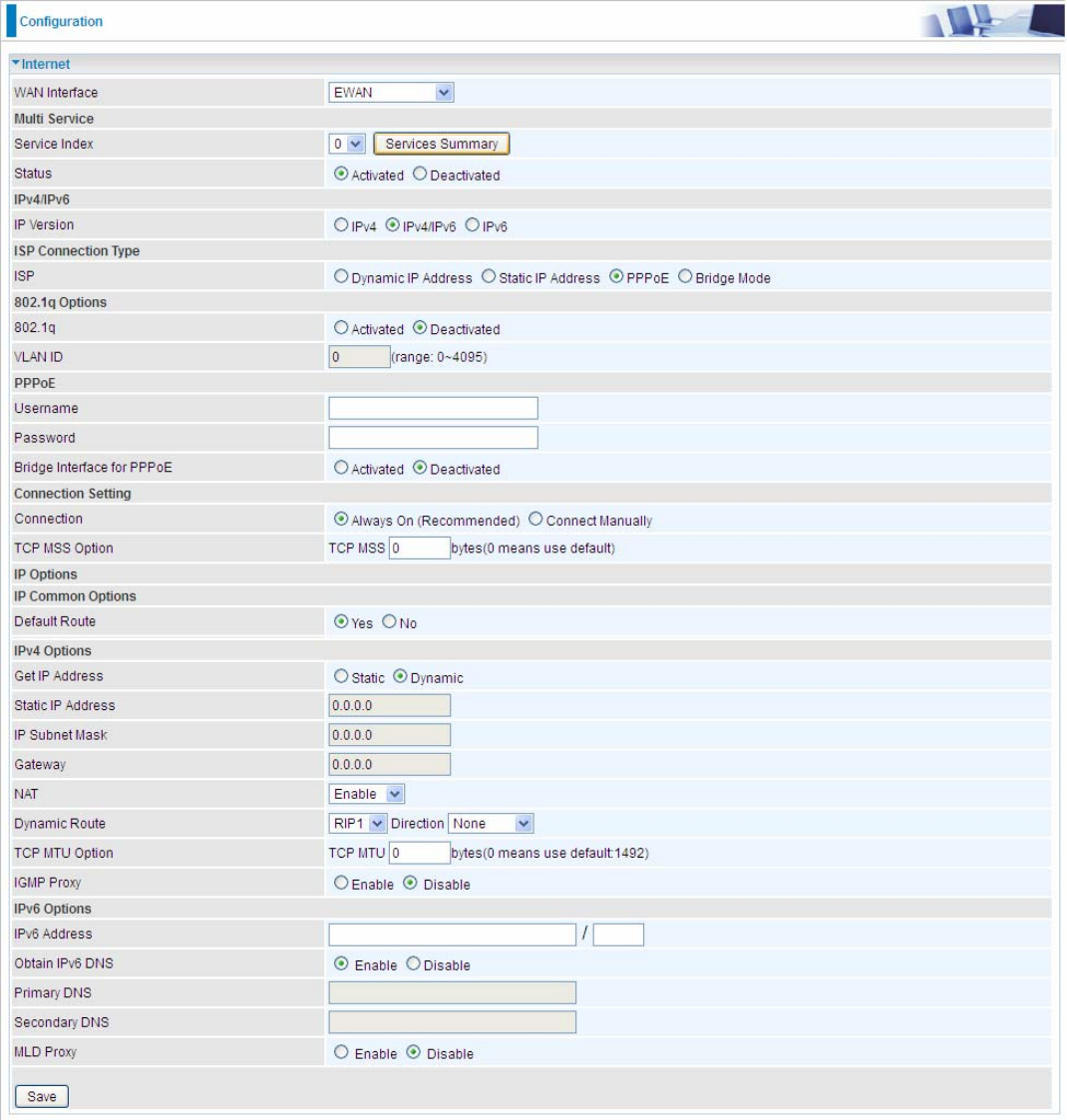
45
4.4.1 Interface Setup
First, let us take a look at the Interface Setup. There are four items contained in this section, namely, Internet,
LAN, Wireless and Wireless MAC Filter. Each is described in the following scenario.
4.4.1.1 Internet
EWAN
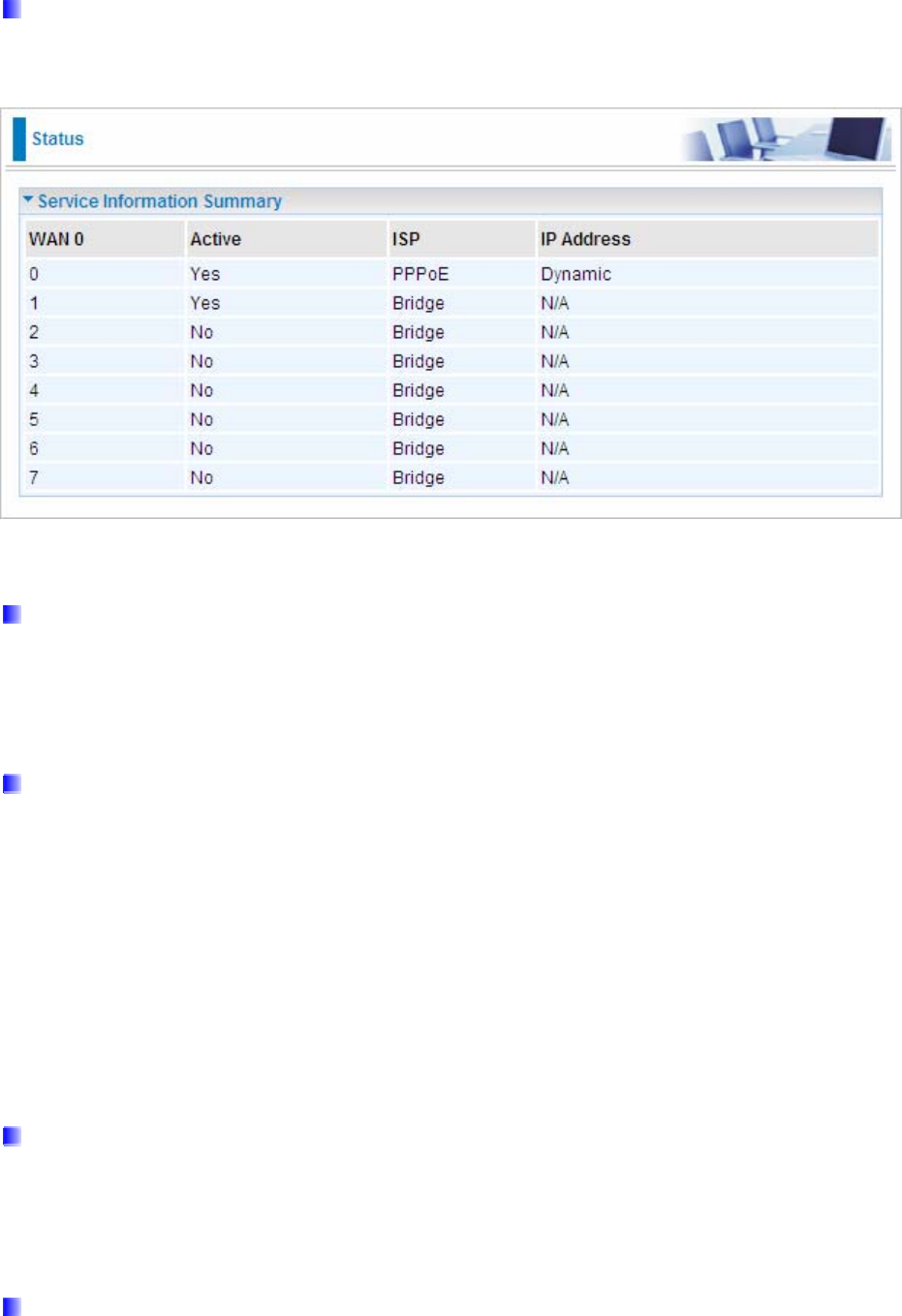
46
Multi Service
Service Index: The index to mark the EWAN interface of different ISP type, ranging from 0-7.
Service Summary: The diagram for view of service information.
Status: Select whether to enable the service.
IPv4/IPv6
IP version: choose IPv4, IPv4/IPv6, IPv6 based on users’ environment.
Here we take IPv4/IPv6 for example, when you just choose IPv4 or IPv6, you can just get information from the
following listed parameters.
ISP Connection Type:
ISP: Select the encapsulation type your ISP uses.
Dynamic IP: Select this option if your ISP provides you an IP address automatically. This option is
typically used for Cable services. Please enter the Dynamic IP information accordingly.
Static IP: Select this option to set static IP information. You will need to enter in the Connection type, IP
address, subnet mask, and gateway address, provided to you by your ISP. Each IP address entered in
the fields must be in the appropriate IP form, which is four IP octets separated by a dot (xx.xx.xx.xx). The
Router will not accept the IP address if it is not in this format.
PPPoE: Select this option if your ISP requires you to use a PPPoE connection.
Bridge: Select this mode if you want to use this device as an OSI layer 2 device like switch.
802.1q Options
802.1q: Select whether to activate 802.1q feature. When activated, please enter the the VLAN ID.
VLAN ID: It is a parameter to specify the VLAN which the frame belongs. Enter the VLAN ID identification,
tagged: 0-4095.
PPPoE
Username: Enter the user name exactly as your ISP assigned.
Password: Enter the password associated with the user name above.
Bridge Interface for PPPoE: When “Activated”, the device will gain WAN IP from your ISP with the PPPoE
account. But if your PC is connected to the router working as a DHCP client, in this mode, the device acts as a
NAT router; while if you dial up with the account within your PC, the device will then work as a bridge forwarding
the PPPoE information to the PPPoE server and send the response to your PC, thus your PC gets a WAN IP

47
working in the internet.
Connection Setting
Connection:
Always On: Click on Always On to establish a PPPoE session during start up and to automatically
re-establish the PPPoE session when disconnected by the ISP.
Connect Manually: Select Connect Manually when you don't want the connection up all the time.
TCP MSS Option: Enter the TCP Maximum Segment Size (MSS).
IP Options
Default Route: Select Yes to use this interface as default route interface.
IPv4 options:
Get IP Address: Choose Static or Dynamic
Static IP Address: If Static is selected in the above field, please enter the specific IP address you get from ISP
and the following IP subnet mask and gateway address.
IP Subnet Mask: The default is 0.0.0.0. User can change it to other such as 255.255.255.0.Type the subnet
mask assigned to you by your ISP (if given).
Gateway: Enter the specific gateway IP address you get from ISP.
NAT: Select Enable if you use this router to hold a group of PCs to get access to the internet.
Dynamic Route:
RIP Version: (Routing Information protocol) Select this option to specify the RIP version, including RIP-1,
RIP-2.
RIP Direction: Select this option to specify the RIP direction.
None is for disabling the RIP function.
Both means the router will periodically send routing information and accept routing information then
incorporate into routing table.
IN only means the router will only accept but will not send RIP packet.
OUT only means the router will only send but will not accept RIP packet.
TCP MTU Option: Maximum Transmission Unit, the maximum is 1500.
IGMP Proxy: IGMP (Internet Group Multicast Protocol) is a network-layer protocol used to establish
membership in a Multicast group. Choose whether enable IGMP proxy.
IPv6 options (only when choose IPv4/IPv6 or just IPv6 in IP version field above):
IPv6 Address: Type the WAN IPv6 address from your ISP.
Obtain IPv6 DNS: Choose if you want to obtain DNS automatically.
Primary/Secondary: if you choose Disable in the Obtain IPv6 DNS field, please type the exactly primary and
secondary DNS.
MLD Proxy: MLD (Multicast Listener Discovery Protocol) is to IPv6 just as IGMP to IPv4. It is a Multicast
Management protocol for IPv6 multicast packets.
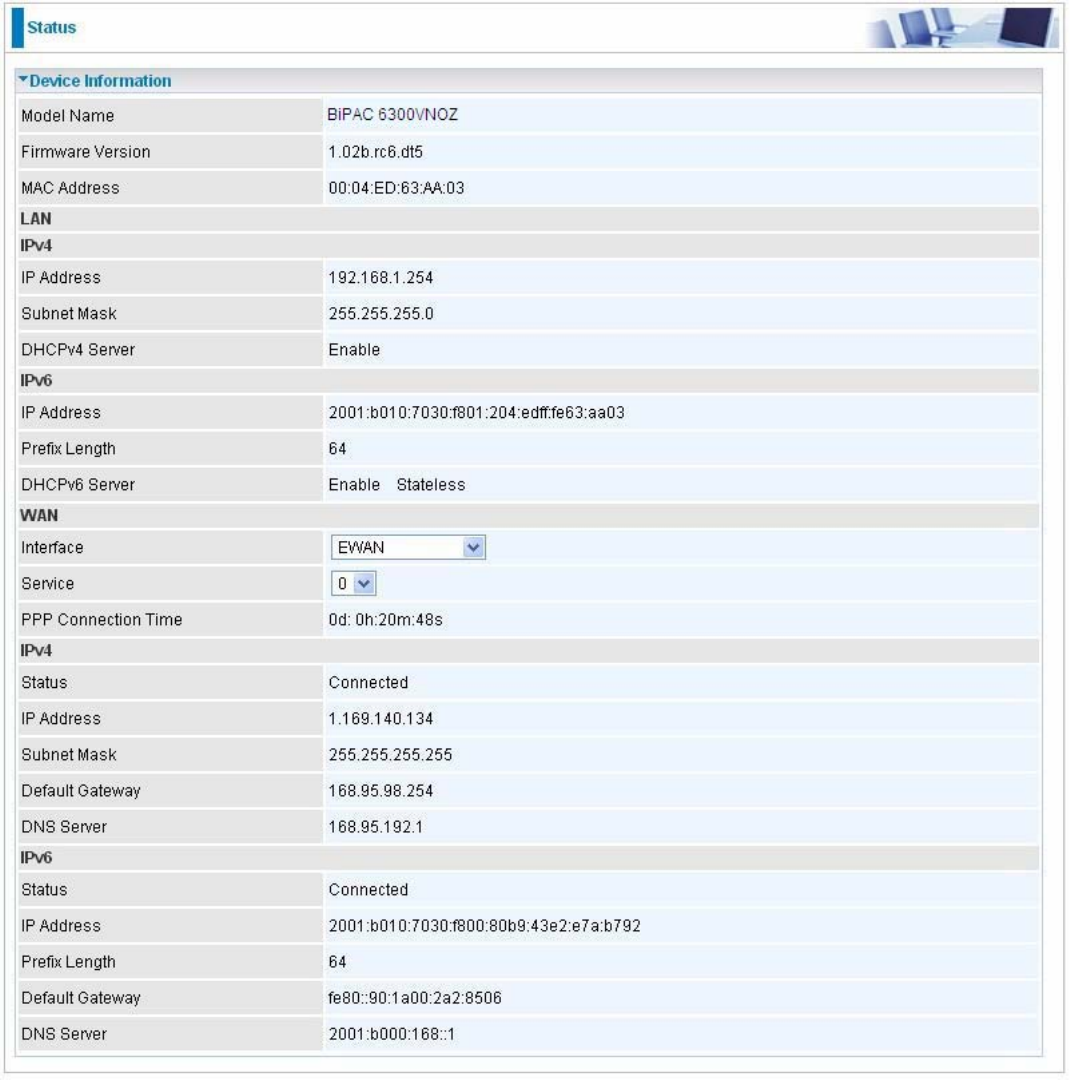
48
When router’s Internet configuration is finished successfully, you can go to status to get the connection
information.
49
4.4.1.2 LAN
A Local Area Network (LAN) is a shared communication system to which many computers are attached and is
limited to the immediate area, usually the same building or floor of a building.
IPv6
The IPv6 address composes of two parts, thus, the prefix and the interface ID.
There are two ways to dynamically configure IPv6 address on hosts. One is statefull configuration, for example
using DHCPv6 (which resembles its counterpart DHCP in IPv4.) In the stateful autoconfiguration model, hosts
obtain interface addresses and/or configuration information and parameters from a DHCPv6 server. The Server
maintains a database that keeps track of which addresses have been assigned to which hosts.
The second way is stateless configuration. Stateless auto-configuration requires no manual configuration of
hosts, minimal (if any) configuration of routers, and no additional servers. The stateless mechanism allows a
host to generate its own addresses using a combination of locally available information (MAC address) and
information (prefix) advertised by routers. Routers advertise prefixes that identify the subnet(s) associated with
a link, while hosts generate an "interface identifier" that uniquely identifies an interface on a subnet. An address
is formed by combining the two. When using stateless configuration, you needn’t configure anything on the
client.
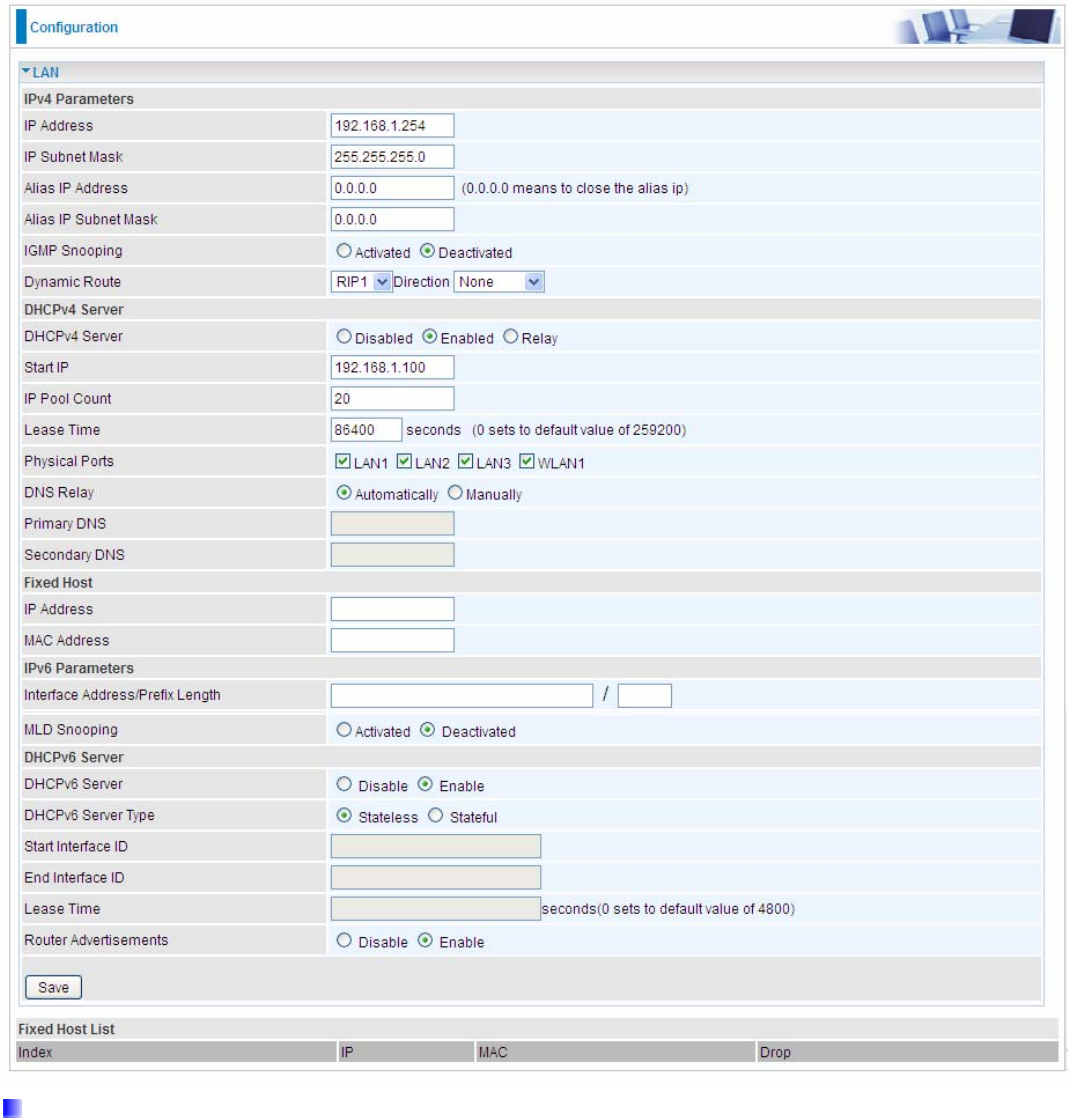
50
IPv4 Parameters
IP Address: Enter the IP address of Router in dotted decimal notation, for example, 192.168.1.254 (factory
default).
IP Subnet Mask: The default is 255.255.255.0. User can change it to other such as 255.255.255.128.
Alias IP Address: This is for local networks virtual IP interface. Specify an IP address on this virtual interface.
Alias IP Subnet Mask: Specify a subnet mask on this virtual interface.
IGMP Snooping: Select Activated to enable IGMP Snooping function, Without IGMP snooping, multicast
traffic is treated in the same manner as broadcast traffic - that is, it is forwarded to all ports. With IGMP snooping,
multicast traffic of a group is only forwarded to ports that have members of that group.
Dynamic Route: Select the RIP version from RIP1 or RIP2.
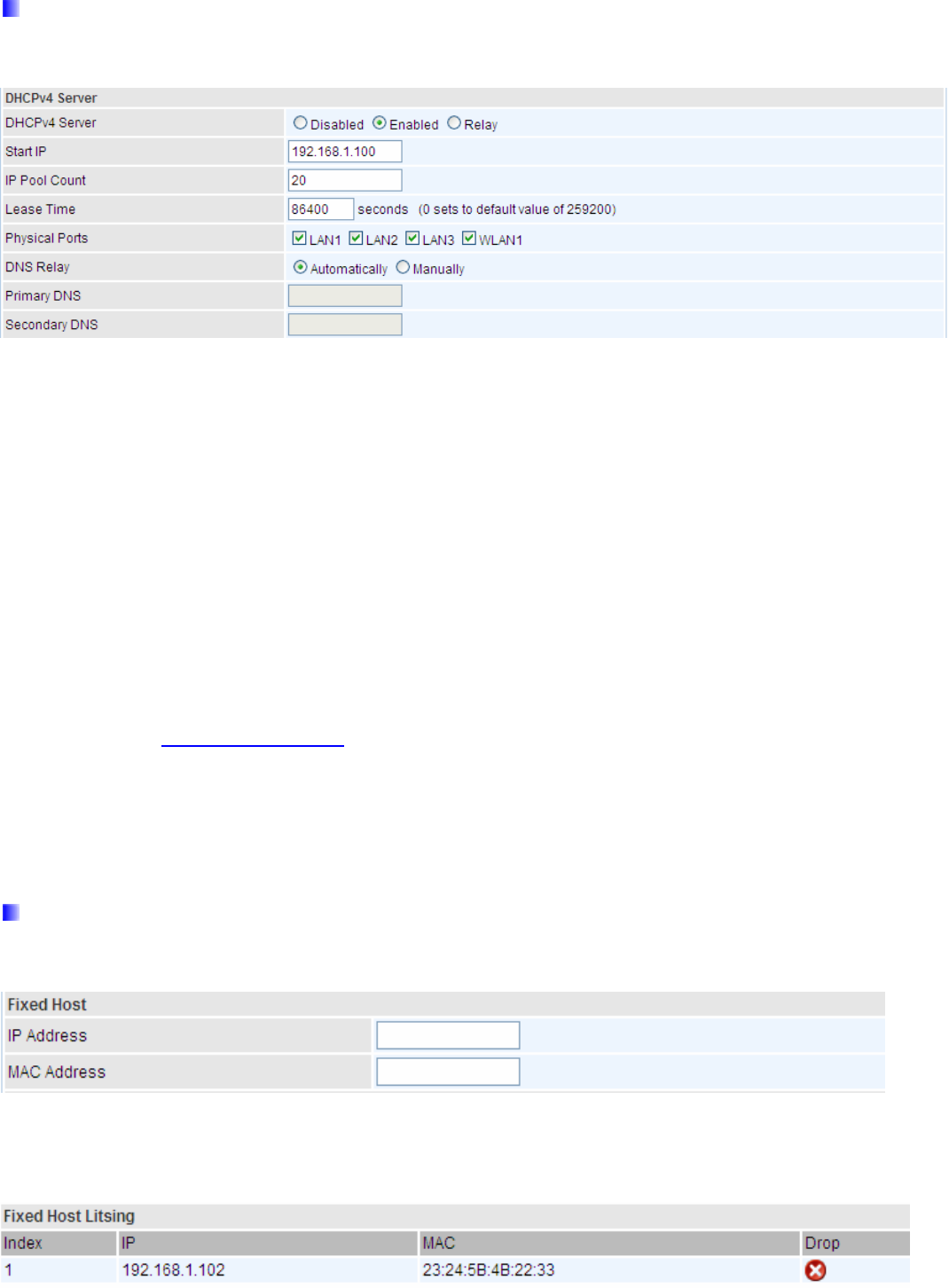
51
DHCPv4 Server
DHCP (Dynamic Host Configuration Protocol) allows individual clients to obtain TCP/IP configuration at start-up
from a server.
DHCPv4 Server: If set to Enabled, your BIPAC 6300VNOZ can assign IP addresses, default gateway and DNS
servers to the DHCP client.
If set to Disabled, the DHCP server will be disabled.
If set to Relay, the BIPAC 6300VNOZ acts as a surrogate DHCP server and relays DHCP requests and
responses between the remote server and the clients. Enter the IP address of the actual, remote DHCP
server in the Remote DHCP Server field in this case.
When DHCP is used, the following items need to be set.
Start IP: This field specifies the first of the contiguous addresses in the IP address pool.
IP Pool Count: This field specifies the count of the IP address pool.
Lease Time: The current lease time of client.
Physical Ports: Select to determine if the DHCPv4 server is applicable to the specific port or ports. By default,
all ports can obtain local IP from DHCPv4 server.
DNS Relay Select Automatically obtained or Manually set (if selected. Please set the exactly information). If you
set Static IP in the ISP Connection Type field, then select Manually here and set the specific DNS information.
Primary DNS Server: Enter the IP addresses of the DNS servers. The DNS servers are passed to the DHCP
clients along with the IP address and the subnet mask.
Secondary DNS Server: Enter the IP addresses of the DNS servers. The DNS servers are passed to the
DHCP clients along with the IP address and the subnet mask.
Fixed Host
In this field, users can map the specific IP (must in the DHCP IP pool) for some specific MAC, and this
information can be listed in the following table.
IP Address: Enter the specific IP. For example: 192.168.1.110.
MAC Address: Enter the responding MAC. For example: 00:0A:F7:45:6D:ED
When added, you can see the ones listed as showed below:
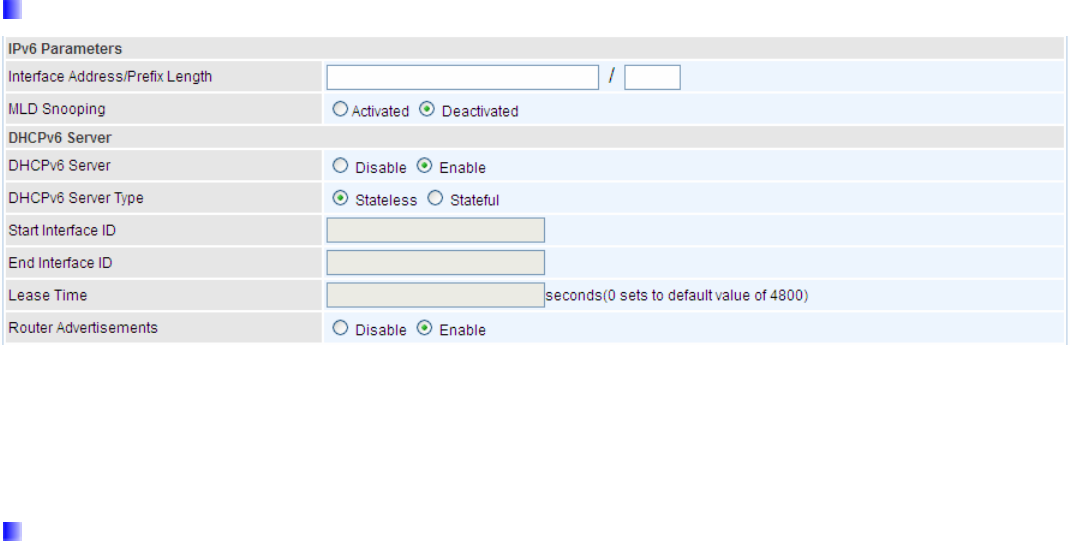
52
IPv6 parameters
Interface Address / Prefix Length: enter the static LAN IPv6 address, we suggest leave the field empty
because when setted wrong, it will result in LAN devices not being able to access other IPv6 device through
internet. Router will take the same WAN’s prefix to LAN side if the field is empty.
MLD Snooping: Similar to IGMP Snooping, but applicable for IPv6.
DHCPv6 Server
DHCPv6 Server: Check whether to enable DHCPv6 server.
DHCPv6 Server Type: Select Stateless or Stateful. When DHCPv6 is enabled, this parameter is available.
Stateless: If selected, the PCs in LAN are configured through RA mode, thus, the PCs in LAN are
configured through RA mode, to obtain the prefix message and generate an address using a
combination of locally available information (MAC address) and information (prefix) advertised by
routers, but they can obtain such information like DNS from DHCPv6 Server.
Stateful: If selected, the PCs in LAN will be configured like in IPv4 mode, thus obtain addresses and
DNS information from DHCPv6 server.
Start interface ID: enter the start interface ID. The IPv6 address composed of two parts, thus, the prefix and the
interface ID. Interface is like the Host ID compared to IPv4.
End interface ID: enter the end interface ID.
Leased Time (hour): the leased time, similar to leased time in DHCPv4, is a time limit assigned to clients, when
expires, the assigned ID will be recycled and reassigned.
Issue Router Advertisement: Check whether to enable issue Router Advertisement feature. It is to send
Router Advertisement messages periodically. Router will multicast the v6 Prefix information (similar to v4
network number 192.168.1.0) to all LAN devices if the field is enabled. We suggest enabling this field.
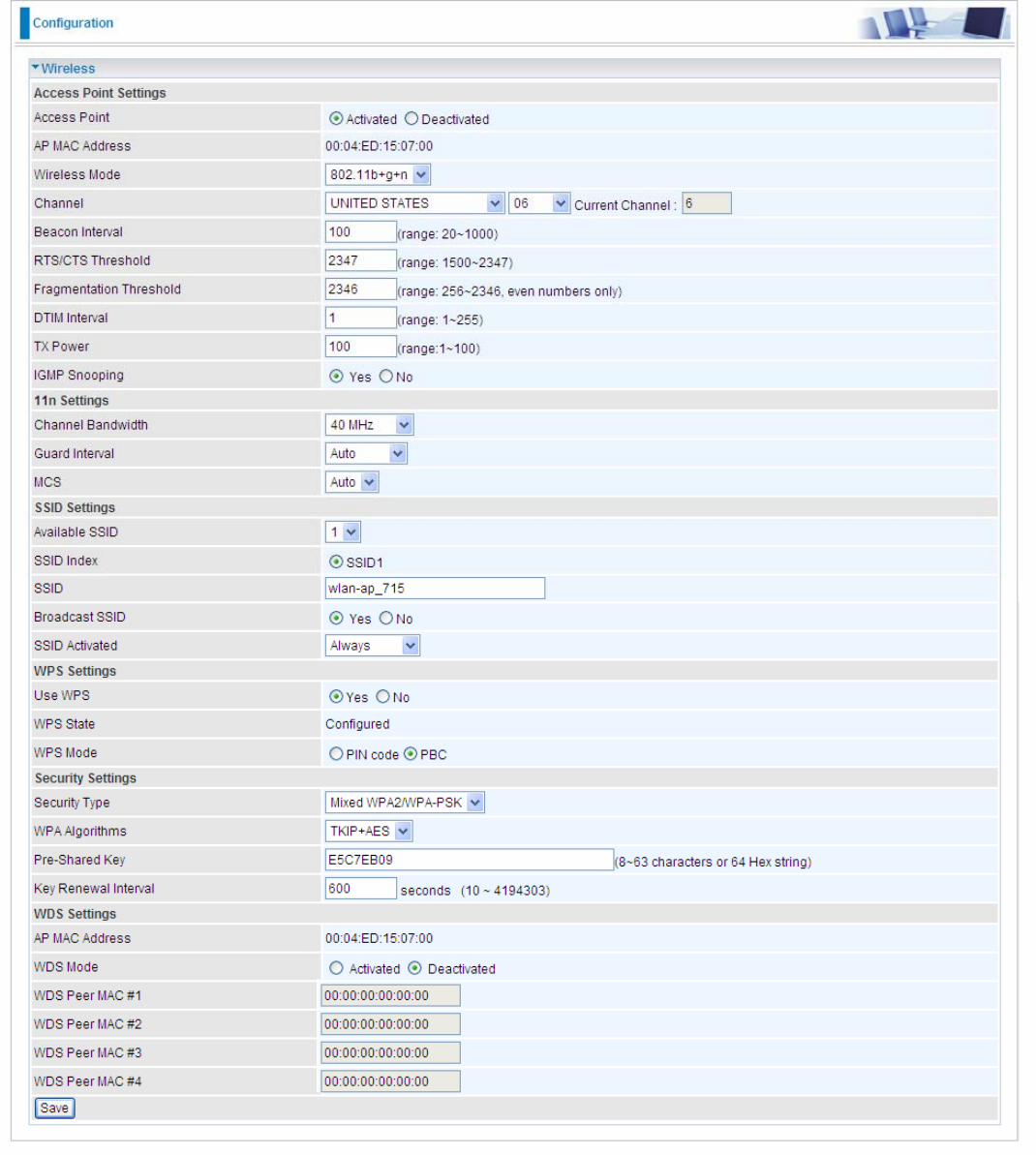
53
4.4.1.3 Wireless
This section introduces the wireless LAN and some basic configurations. Wireless LANs can be as complex as
a number of computers with wireless LAN cards communicating through access points which bridge network
traffic to the wired LAN.
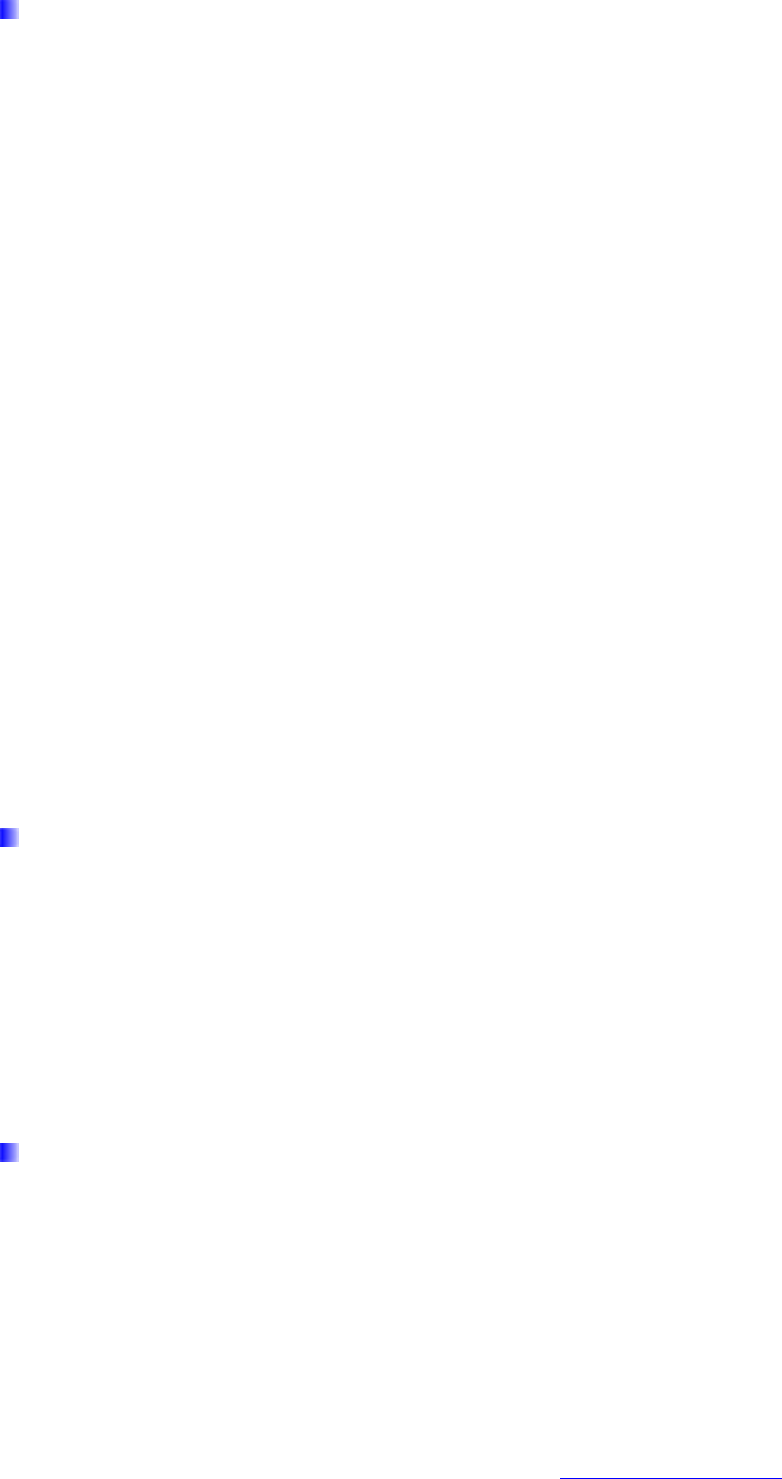
54
Access Point Settings
Access Point: Default setting is set to Activated. If you want to close the wireless interface, select
Deactivated.
AP MAC Address: The MAC address of wireless AP.
Wireless Mode: The default setting is 802.11b+g+n (Mixed mode). If you do not know or have both 11g and
11b devices in your network, then keep the default in mixed mode. From the drop-down manual, you can select
802.11g if you have only 11g card. If you have only 11b card, then select 802.11b and if you only have 802.11n
then select 802.11n.
Channel: The range of radio frequencies used by IEEE 802.11b/g/n wireless devices is called a channel. There
are Regulation Domains and Channel ID in this field. The Channel ID will be different based on Regulation
Domains. Select a channel from the drop-down list box.
Beacon interval: The Beacon Interval value indicates the frequency interval of the beacon. Enter a value
between 20 and 1000. A beacon is a packet broadcast by the Router to synchronize the wireless network.
RTS/CTS Threshold: The RTS (Request To Send) threshold (number of bytes) for enabling RTS/CTS
handshake. Data with its frame size larger than this value will perform the RTS/CTS handshake. Enter a value
between 1500 and 2347.
Fragmentation Threshold: The threshold (number of bytes) for the fragmentation boundary for directed
messages. It is the maximum data fragment size that can be sent. Enter a value between 256 and 2346, even
number only.
DTIM Interval: This value, between 1 and 255, indicates the interval of the Delivery Traffic Indication Message
(DTIM).
TX Power: The transmission power of the antennas, ranging from 1-100, the higher the more powerful of the
transmission performance.
IGMP Snooping: Enable or disable the IGMP Snooping function for wireless. Without IGMP snooping,
multicast traffic is treated in the same manner as broadcast traffic - that is, it is forwarded to all ports. With IGMP
snooping, multicast traffic of a group is only forwarded to ports that have members of that group.”
11n Settings
Channel Bandwidth: Select either 20 MHz or 20/40 MHz for the channel bandwidth. The wider the Channel
bandwidth the better the performance will be.
Guard Interval: Select either 400nsec or 800nsec for the guard interval. The guard interval is here to ensure
that data transmission do not interfere with each other. It also prevents propagation delays, echoing and
reflections. The shorter the Guard Interval, the better the performance will be. We recommend users to select
Auto.
MCS: There are options 0~15 and AUTO to select for the Modulation and Coding Scheme. We recommend
users selecting AUTO.
SSID Settings
Available SSID: User can determine how many virtual SSIDs to be used. Default is 1, maximum is 4.
SSID Index: Select how many SSIDs you want to lay out. A total of 4 is in list. By default 4 SSIDs are in use.
SSID: The SSID is the unique name of a wireless access point (AP) to be distinguished from another. For
security propose, change the default wlan-ap to a unique ID name to the AP which is already built-in to the
router’s wireless interface. Make sure your wireless clients have exactly the SSID as the device, in order to get
connected to your network.
Broadcast SSID: Select Yes to make the SSID visible so a station can obtain the SSID through passive
scanning. Select No to hide the SSID in so a station cannot obtain the SSID through passive scanning.
SSID Activated: Select the time period during which the SSID is active. Default is always which means the
SSID will be active all the time without time control. See 4.4.2.8 Time Schedule to set the timeslot to flexibly
control when the SSID functions.
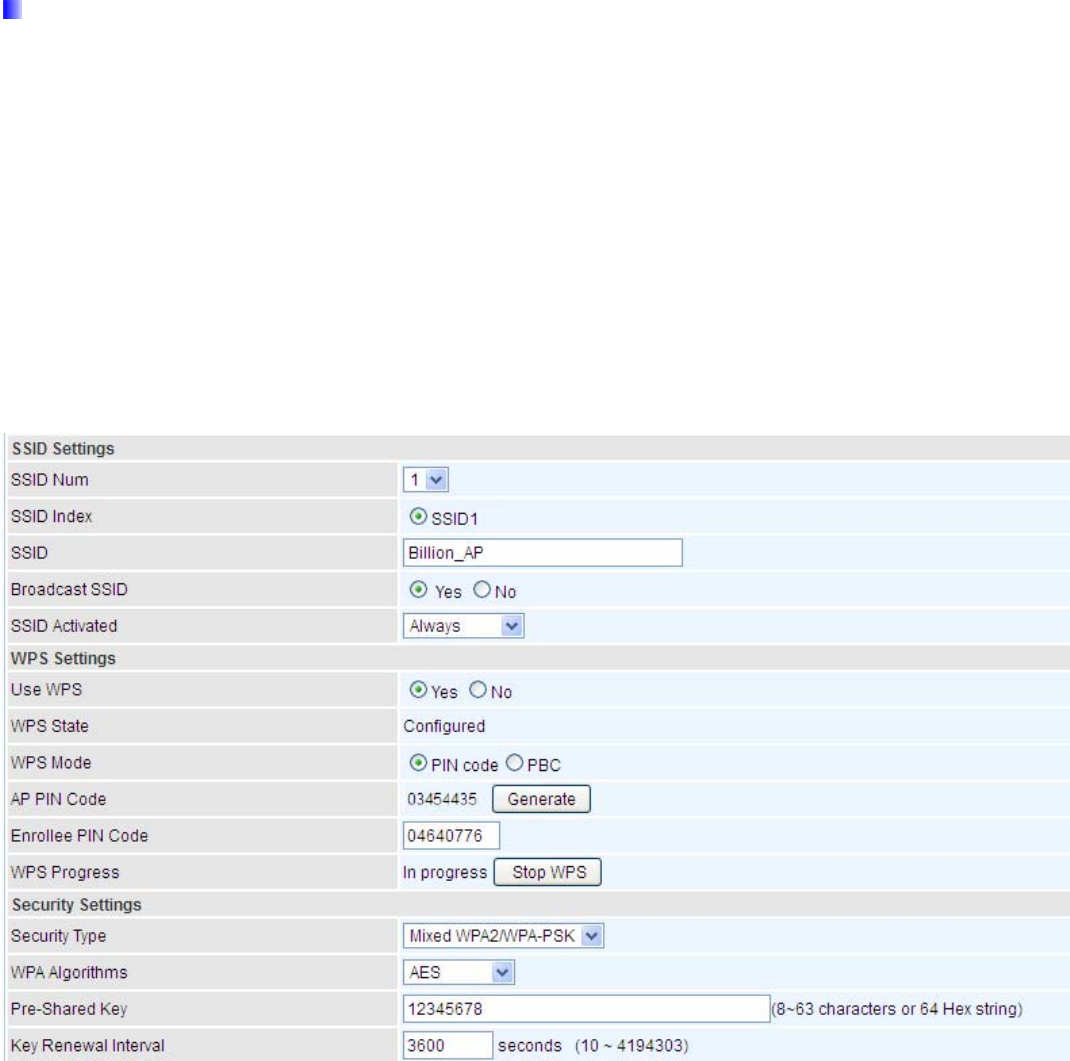
55
WPS Settings
WPS (Wi-Fi Protected Setup) feature is a standard protocol created by Wi-Fi Alliance. This feature greatly
simplifies the steps needed to create a Wi-Fi networks for a residential or an office setting. WPS supports 2
types of configuration methods which are commonly known among consumers: PIN Method & PBC Method.
WPS State: Display whether the WPS is configured or unconfigured.
WPS Mode: Select the mode which to start WPS, choose between PIN Code and PBC (Push Button).
Selecting Pin Code mode will require you to know the enrollee PIN code.
To future understand the two modes of configuration; please refer to the following Wi-Fi Protected Setup.
Wi-Fi Protected Setup
PIN Method: Configure AP as Registrar
1. Jot down the client’s Pin (eg. 04640776).
2. Enter the Enrollee(Client) PIN code and then press Start WPS.
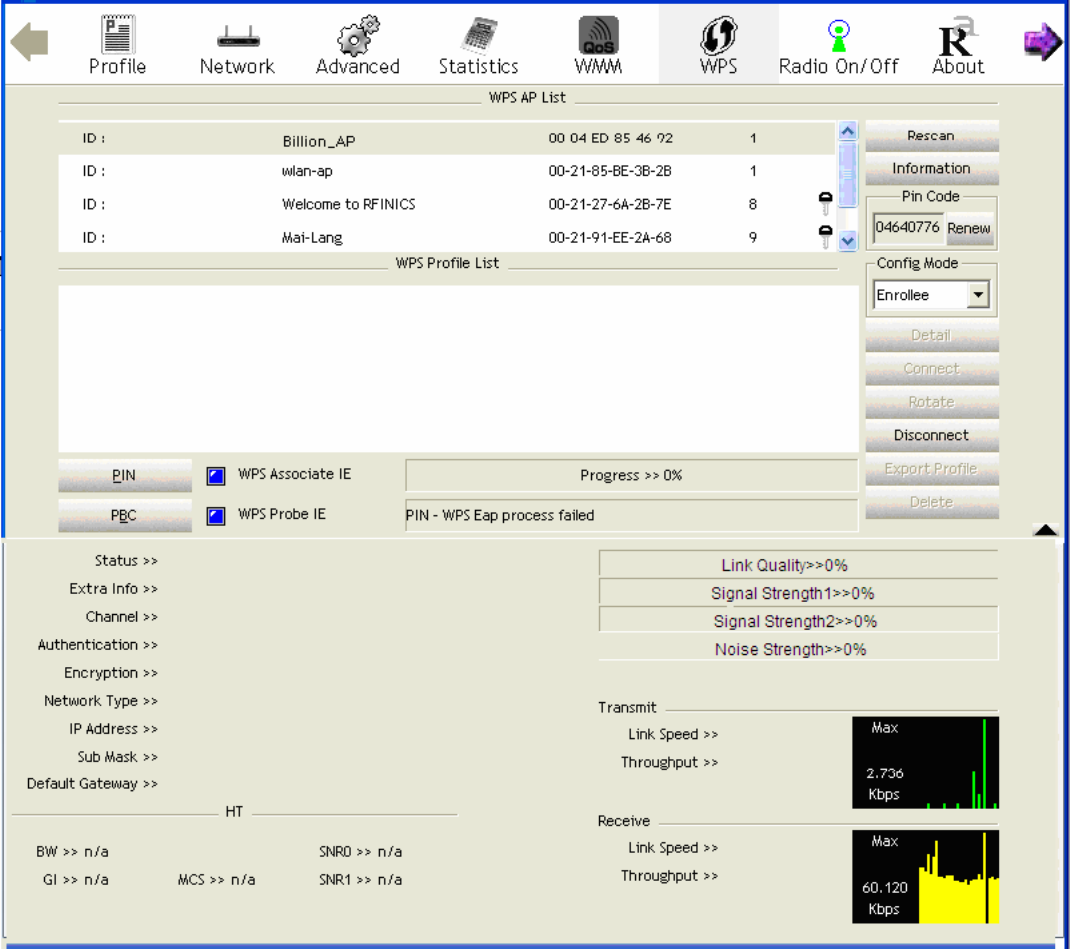
56
3. Launch the wireless client’s WPS utility (eg. Ralink Utility). Set the Config Mode as Enrollee, press the WPS
button on the top bar, select the AP (eg. Billion_AP) from the WPS AP List column. Then press the PIN button
located on the middle left of the page to run the scan.
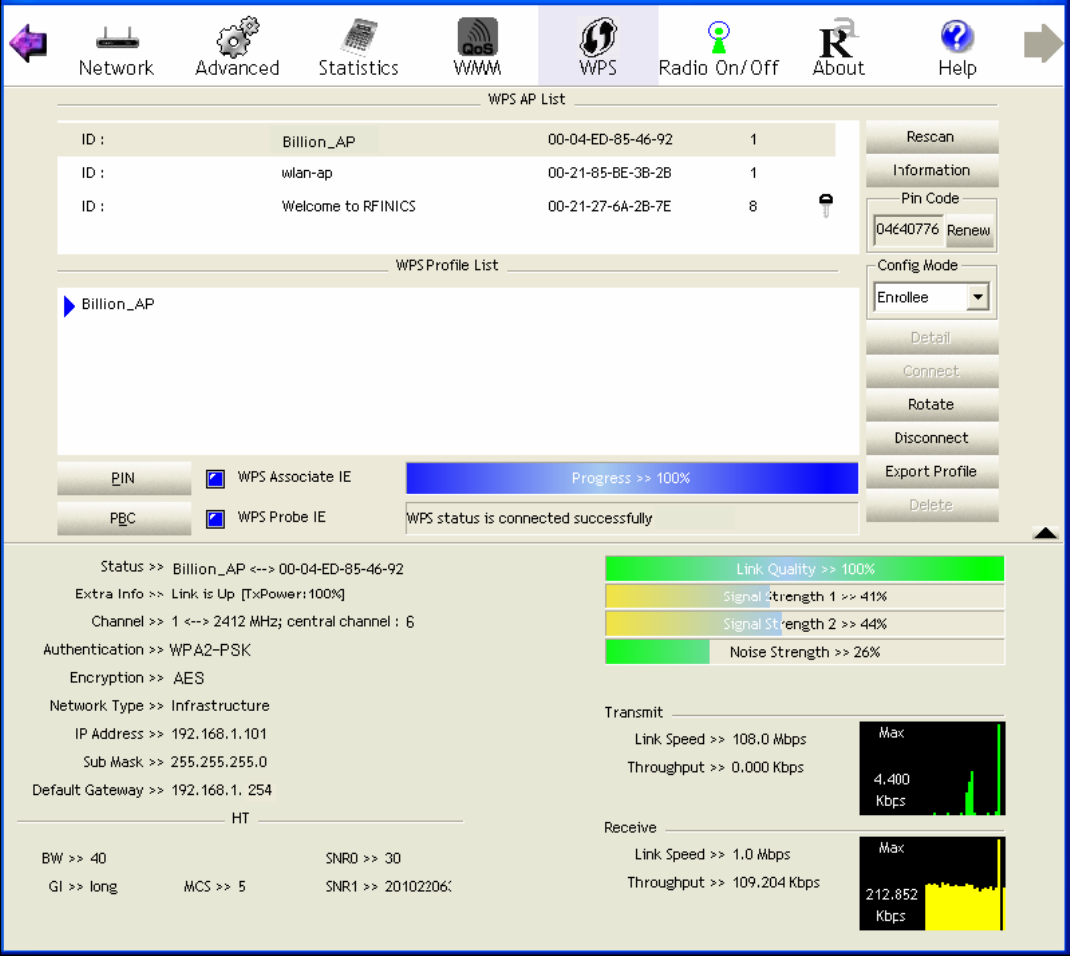
57
4. The client’s SSID and security setting will now be configured to match the SSID and security setting of the
registrar (router).
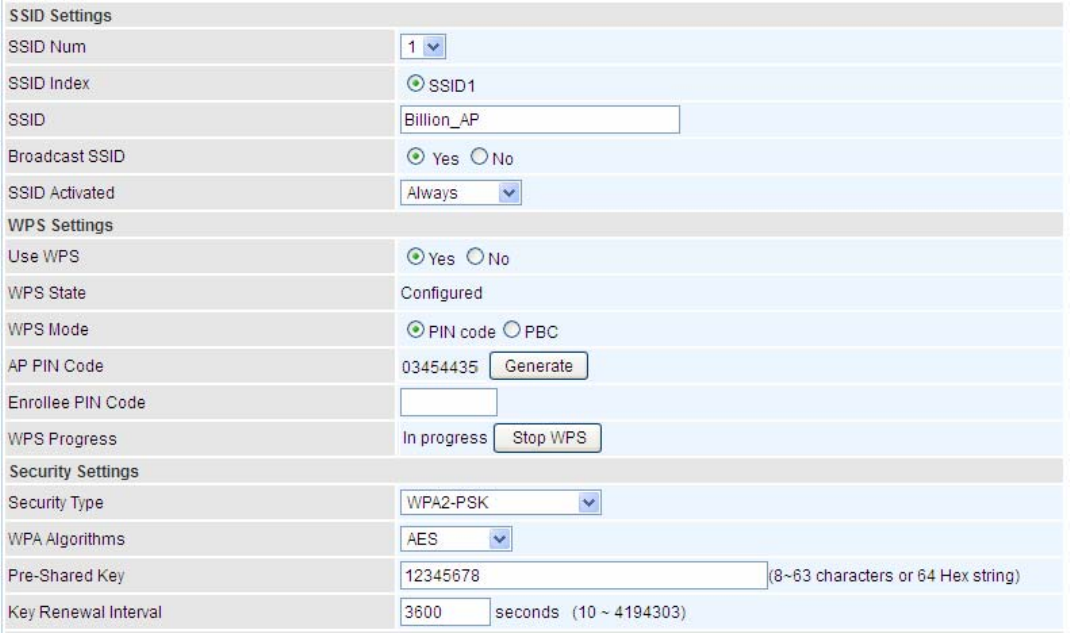
58
PIN Method: Configure AP as Enrollee
1. Jot down the WPS PIN (eg. 03454435).Press Start WPS.
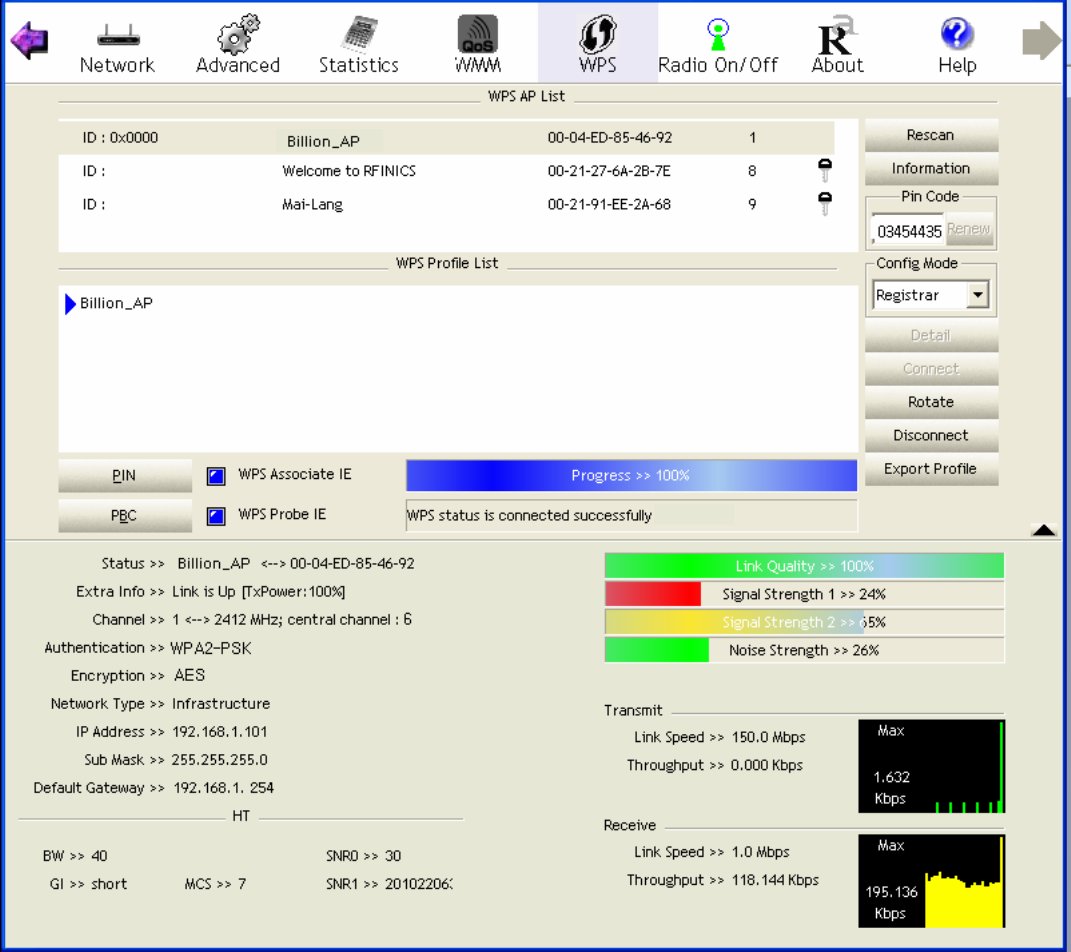
59
2. Launch the wireless client’s WPS utility (eg. Ralink Utility). Set the Config Mode as Registrar. Enter the PIN
number in the PIN Code column then choose the correct AP (eg. Billion_AP) from the WPS AP List before
pressing the PIN button to run the scan.
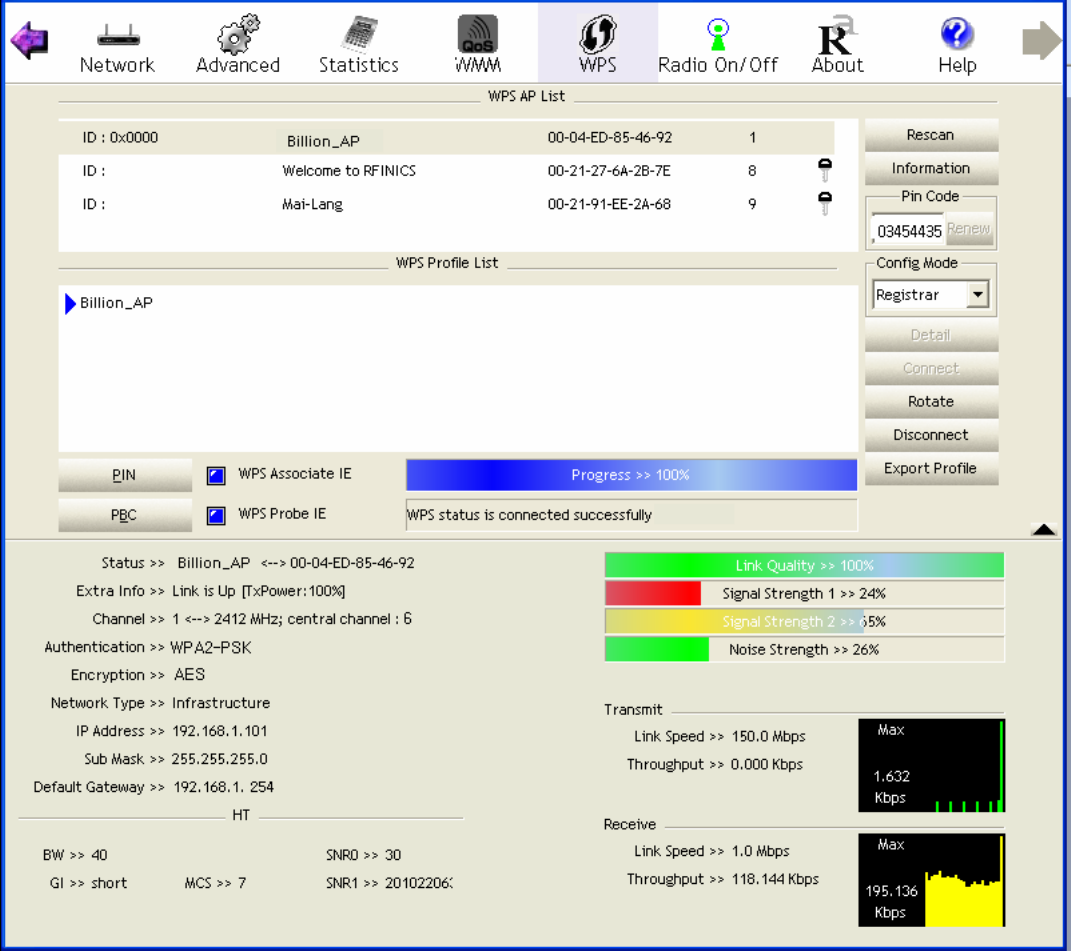
60
3. The router’s (AP’s) SSID and security setting will now be configured to match the SSID and security setting of
the registrar (client).
4. Now to make sure that the setup is correctly done, cross check to see if the SSID and the security setting of
the registrar setting match with the parameters found on both Wireless Configuration and Wireless Security
Configuration page.
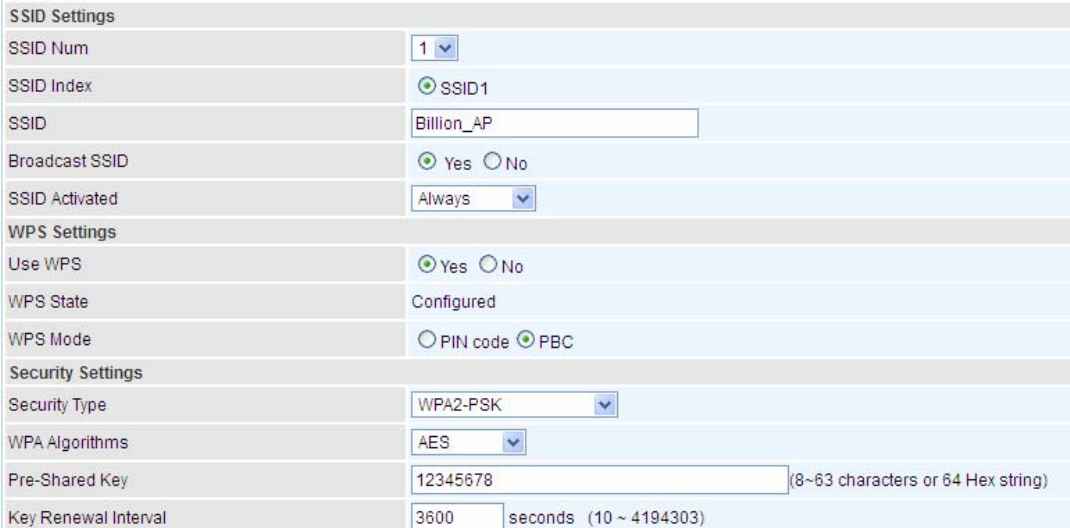
61
PBC Method:
1. Press the PBC radio button, Then Start WPS.
2. Launch the wireless client’s WPS Utility (eg. Ralink Utility). Set the Config Mode as Enrollee. Then press the
WPS button and choose the correct AP (eg. Billion_AP) from the WPS AP List section before pressing the PBC
button to run the scan.
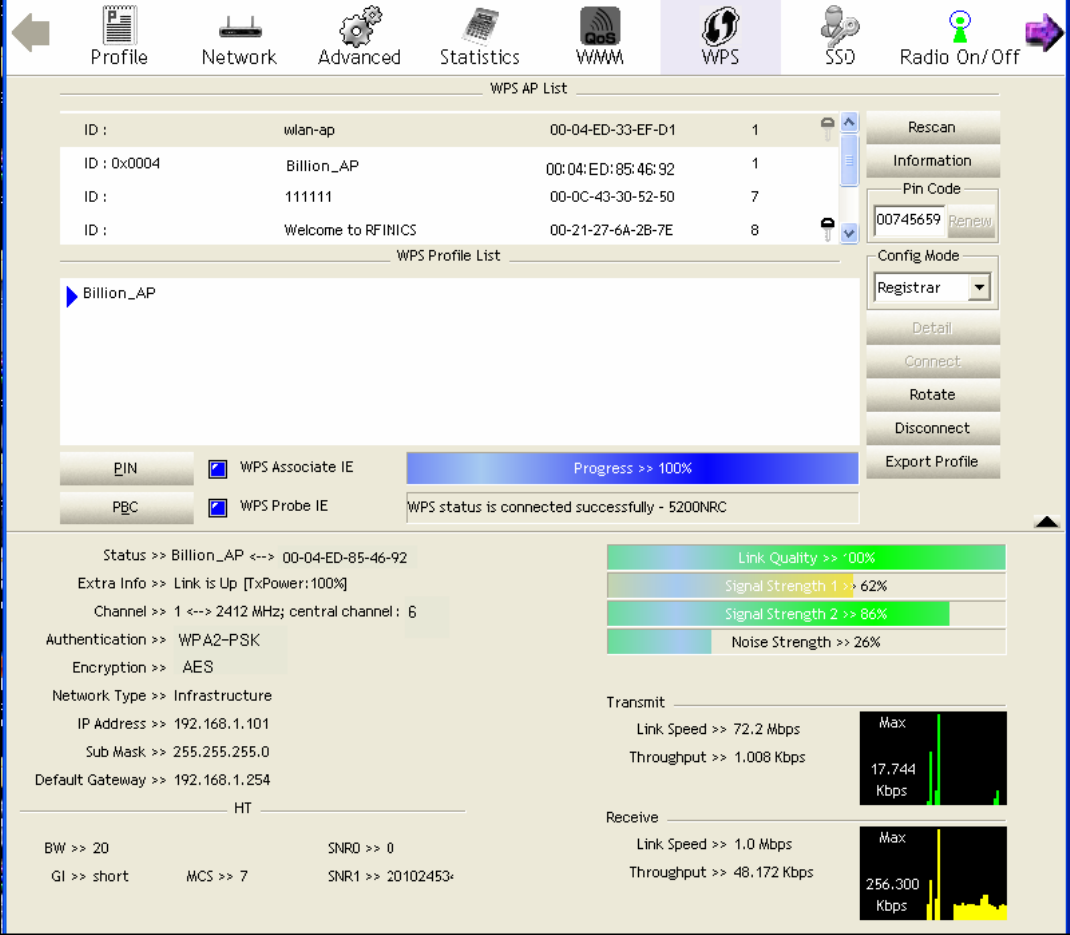
62
3. When the PBC button is pushed, a wireless communication will be established between your router and the
PC. The client’s SSID and security setting will now be configured to match the SSID and security setting of the
router.
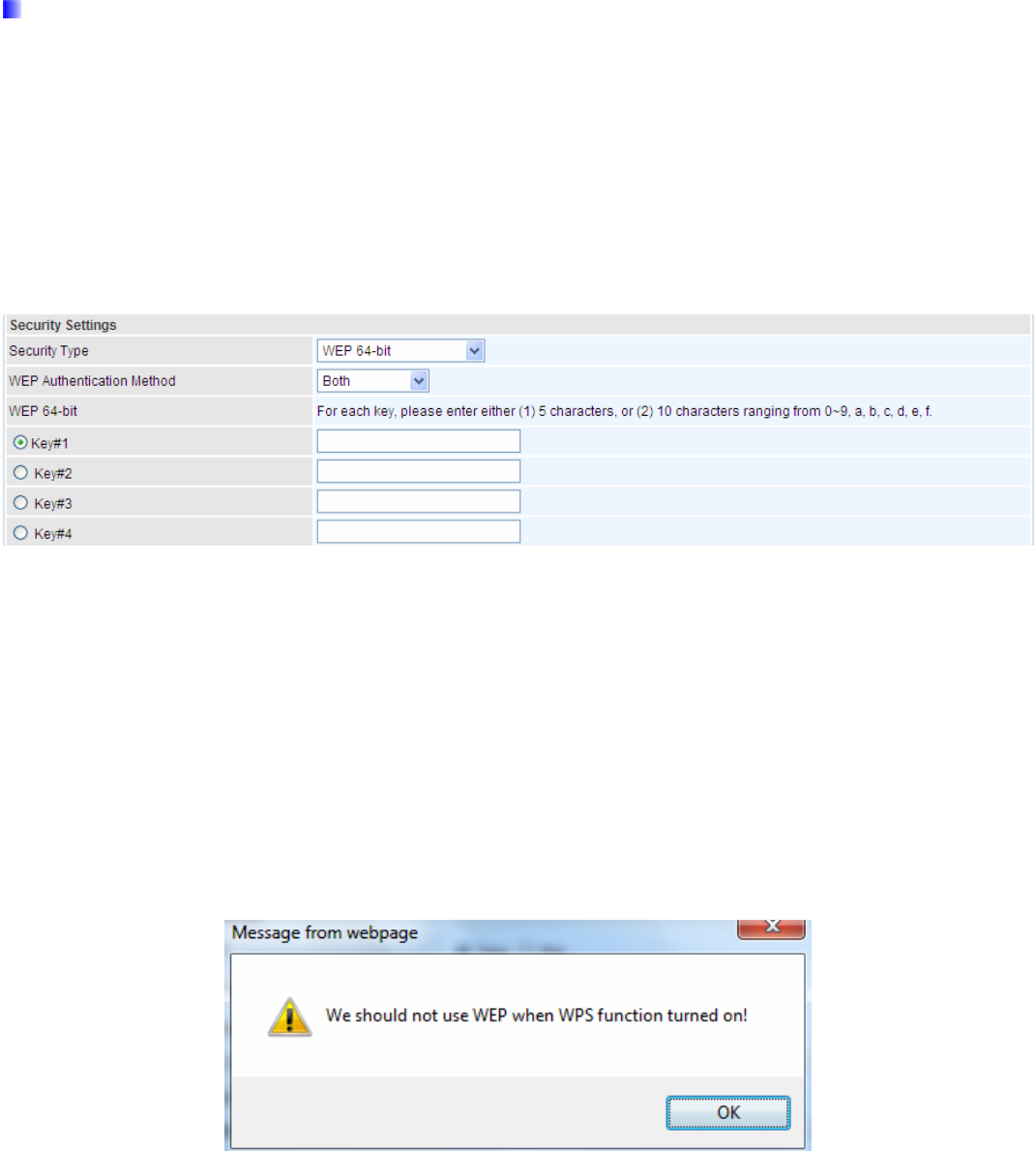
63
Security Settings
Security Type: You can disable or enable wireless security for protecting wireless network. The default type of
wireless security is OPEN and to allow all wireless stations to communicate with the access points without any
data encryption.
To prevent unauthorized wireless stations from accessing data transmitted over the network, the router offers
secure data encryption, known as WEP and WPA.
There are five alternatives to select from: WEP 64-bit, WEP 128-bit, WPA-PSK, WPA2-PSK, Mixed
WPA/WPA2-PSK. If you require high security for transmissions, please select WPA-PSK, WPA2-PSK or
WPA/WPA2-PSK.
WEP
WEP Authentication Method: WEP authentication method, there are two methods of authentication used,
Open System authentication (OPENWEB) and Share Key authentication (SHAREDWEB). We suggest you
select OPENWEB.
Key 1 to Key 4: Enter the key to encrypt wireless data. To allow encrypted data transmission, the WEP
Encryption Key values on all wireless stations must be the same as the router. There are four keys for your
selection. The input format is in HEX style, 5 and 13 HEX codes are required for 64-bitWEP and 128-bitWEP
respectively.
If you chose WEP 64-bit, then enter any 5 ASCII characters or 10 hexadecimal characters ("0-9", "A-F").
If you chose WEP 128-bit, then enter 13 ASCII characters or 26 hexadecimal characters ("0-9", "A-F").
You must configure all four keys, but only one key can be activated at any one time. The default key is key 1.
Note: When you enable WPS function, this WEP function will be invalid. And if you select one of WEP-64Bits/
WEP-128Bits, the following prompt box will appear to notice you.
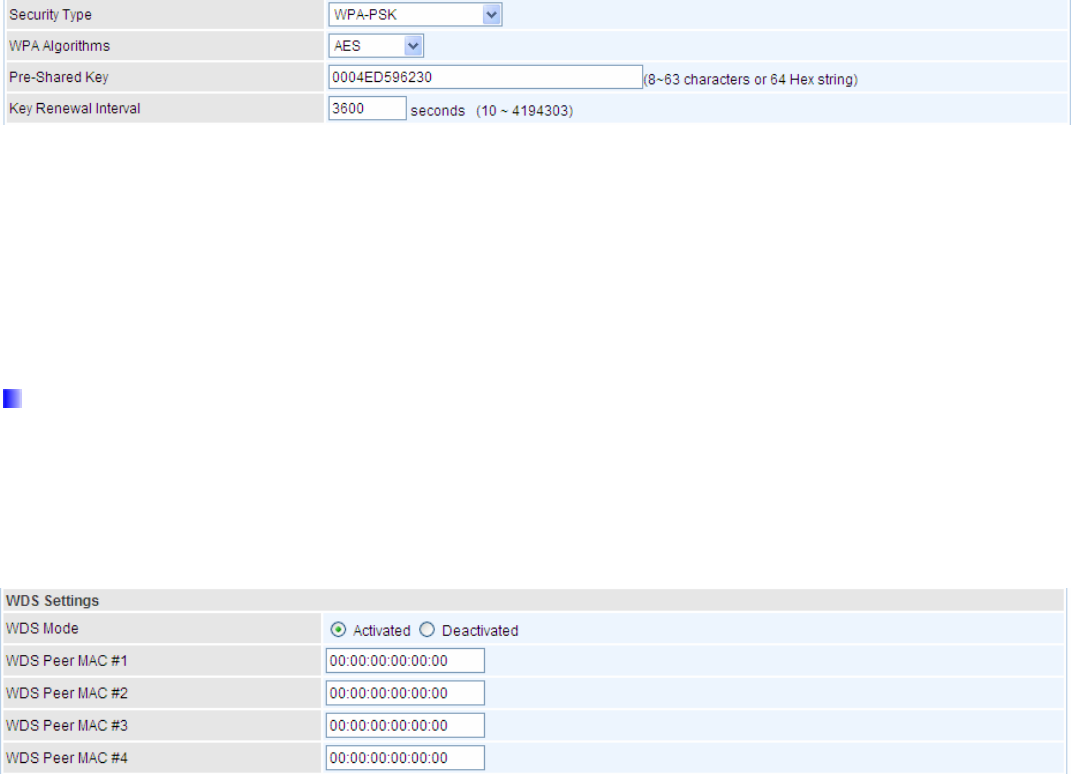
64
WPA-PSK & WPA2-PSK
WPA Algorithms: TKIP (Temporal Key Integrity Protocol) or AES (Advanced Encryption System) utilizes a
stronger encryption method and incorporates Message Integrity Code (MIC) to provide protection against
hackers.
Pre-Shared key: The key for network authentication. The input format should be 8-63 ASKII characters or 64
hexadecimal characters
Key Renewal Interval: The time interval for changing the security key automatically between wireless client
and AP.
WDS Settings
WDS (Wireless distributed system) is a wireless access point mode that enables wireless link and
communication with other access point. It is easy to be installed, just define the peer’s MAC of the connected
AP.
WDS Mode: select Activated to enable WDS feature and Deactivated to disable this feature.
MAC Address: Enter the AP MAC addresses (in XX:XX:XX:XX:XX:XX format) of the peer connected AP.

65
4.4.1.4 Wireless MAC Filter
The MAC filter screen allows you to configure the router to give exclusive access to up to 8 devices (Allow
Association) or exclude up to 8 devices from accessing the router (Deny Association). Every Ethernet device
has a unique MAC (Media Access Control) address. The MAC address is assigned at the factory and consists of
six pairs of hexadecimal characters, for example, 00:AA:BB:00:00:02. You need to know the MAC address of
the devices to configure this screen.
SSID Index: Select the targeted SSID you want the MAC filter rules to apply to.
Active: Select Activated to enable MAC address filtering.
Action: Define the filter action for the list of MAC addresses in the MAC address filter table.
Select Deny to block access to the AP, MAC addresses not listed will be allowed to access the router. Select
Allow to permit access to the router, MAC addresses not listed will be denied access to the router.
MAC Address: Enter the MAC addresses (in XX:XX:XX:XX:XX:XX format) of the wireless station that are
allowed or denied access to the specified in these address fields.

66
4.4.2 Advanced Setup
Advanced Step provides some advanced features including Firewall, Routing, NAT, Static DNS, QoS,
Internet Grouping, Port Isolation and Time Schedule for all advanced users. Please move on to have a
picture of what the exact feature is about and how to use it.
4.4.2.1 Firewall
Your router includes a firewall for helping to prevent attacks from hackers. In addition to this, when using NAT
(Network Address Translation) the router acts as a “natural” Internet firewall, since all PCs on your LAN use
private IP addresses that cannot be directly accessed from the Internet.
Firewall: To automatically detect and block Denial of Service (DoS) attacks, such as Ping of Death, SYN Flood,
Port Scan and Land Attack.
Enabled: It activates your firewall function.
Disabled: It disables the firewall function.
SPI: If you enabled SPI, all traffics initiated from WAN would be blocked, including DMZ, Virtual Server, and ACL
WAN side.
Enabled: It activates your SPI function.
Disabled: It disables the SPI function.

67
4.4.2.2 Routing
This is static route feature. You are equipped with the capability to control the routing of all the traffic across your
network. With each routing rule created, user can specifically assign the destination where the traffic will be
routed to.
#: Item number
Destination IP Address: IP address of the destination network
Subnet Mask: The subnet mask of destination network.
Gateway IP Address: IP address of the gateway or existing interface that this route uses.
Metric: It represents the cost of transmission for routing purposes. The number need not be precise, but it must
be between 1 and 15.
Interface: Media/channel selected to append the route.
Edit: Edit the route; this icon is not shown for system default route.
Drop: Drop the route; this icon is not shown for system default route.

68
ADD Route
Destination IP Address: This is the destination subnet IP address.
Destination Subnet Mask: The subnet mask of destination network.
Gateway IP Address/Interface:This is the gateway IP address or existing interface to which packets are to be
forwarded.
Metric:It represents the cost of transmission for routing purposes. The number need not be precise, but it must
be between 1 and 15.
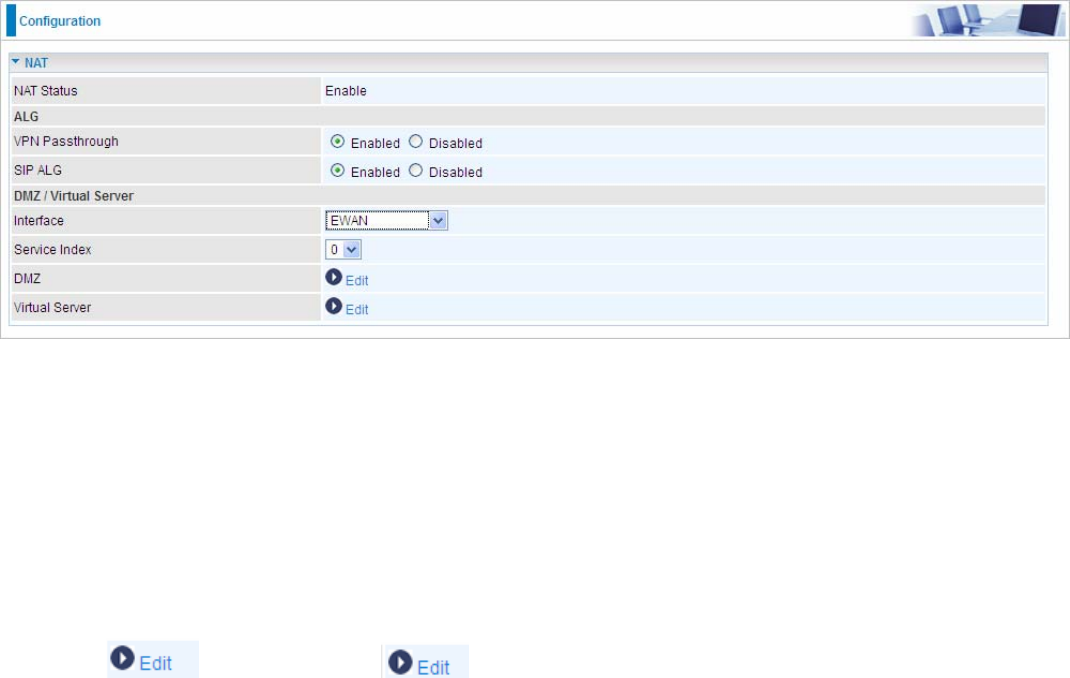
69
4.4.2.3 NAT
The NAT (Network Address Translation) feature transforms a private IP into a public IP, allowing multiple users
to access the internet through a single IP account, sharing the single IP address. NAT break the originally
envisioned model of IP end-to-end connectivity across the internet so NAT can cause problems where IPSec/
PPTP encryption is applied or some application layer protocols such as SIP phones are located behind a NAT.
And NAT makes it difficult for systems behind a NAT to accept incoming communications.
In this session, there are “VPN Passthrough”, “SIP ALG”, “DMZ” and “Virtual Server” provided to solve these
nasty problems.
NAT Status: Enabled. It depends on ISP Connection Type in Internet settings.
VPN Passthrough: VPN pass-through is a feature of routers which allows VPN client on a private network to
establish outbound VPNs unhindered.
SIP ALG: Enable the SIP ALG when SIP phone needs ALG to pass through the NAT. Disable the SIP ALG when
SIP phone includes NAT-Traversal algorithm.
Interface: Select to set DMZ/Virtual Server for “EWAN”.
Service Index: Associated to EWAN interface marking each EWAN service (0-7), to select which EWAN
service the DMZ and Virtual server are applied to.
Click DMZ or Virtual Server to move on to set the DMZ or Virtual Server parameters, which
are represented in the following scenario.

70
DMZ
The DMZ Host is a local computer exposed to the Internet. When setting a particular internal IP address as the
DMZ Host, all incoming packets will be checked by the Firewall and NAT algorithms then passed to the DMZ
host, when a packet received does not use a port number used by any other Virtual Server entries.
DMZ for: Indicate the related WAN interface which allows outside network to connect in and communicate.
Note: Here you can see the Multiple IPs Account/EWAN Service ID 0. It is the interface set in the previous NAT
page.
DMZ:
Enabled: It activates your DMZ function.
Disabled: It disables the DMZ function.
DMZ Host IP Address: Give a static IP address to the DMZ Host when Enabled radio button is checked. Be
aware that this IP will be exposed to the WAN/Internet.
Select the Save button to apply your changes.

71
Virtual Server
In TCP/IP networks a port is a 16-bit number used to identify which application program (usually a server)
incoming connections should be delivered to. Some ports have numbers that are pre-assigned to them by the
IANA (the Internet Assigned Numbers Authority), and these are referred to as “well-known ports”. Servers follow
the well-known port assignments so clients can locate them.
If you wish to run a server on your network that can be accessed from the WAN (i.e. from other machines on the
Internet that are outside your local network), or any application that can accept incoming connections (e.g.
Peer-to-peer/P2P software such as instant messaging applications and P2P file-sharing applications) and are
using NAT (Network Address Translation), then you will usually need to configure your router to forward these
incoming connection attempts using specific ports to the PC on your network running the application. You will
also need to use port forwarding if you want to host an online game server.
The reason for this is that when using NAT, your publicly accessible IP address will be used by and point to your
router, which then needs to deliver all traffic to the private IP addresses used by your PCs. Please see the WAN
configuration section of this manual for more information on NAT.
The device can be configured as a virtual server so that remote users accessing services such as Web or FTP
services via the public (WAN) IP address can be automatically redirected to local servers in the LAN network.
Depending on the requested service (TCP/UDP port number), the device redirects the external service request
to the appropriate server within the LAN network.
Virtual Server for: Indicate the related WAN interface which allows outside network to connect in and
communicate.
Protocol: Choose the application protocol.
Start Port Number: Enter a port number as the starting number of the range which you want to give access to
internal server.
End Port Number: Enter a port number as the end number of the range which you want to give access to
internal server..

72
Local IP Address: Enter your server IP address in this field.
Start Port Number (Local): Please enter the start port number of the local application (service).
End Port Number (Local): Please enter the end port number of the local application (service).
Examples of well-known and registered port numbers are shown below. For further information, please see
IANA’s website at http://www.iana.org/assignments/port-numbers
Well-known and Registered Ports
Port Number Protocol Description
21 TCP FTP Control
22 TCP & UDP SSH Remote Login Protocol
23 TCP Telnet
25 TCP SMTP (Simple Mail Transfer Protocol)
53 TCP & UDP DNS (Domain Name Server)
69 UDP TFTP (Trivial File Transfer Protocol)
80 TCP World Wide Web HTTP
110 TCP POP3 (Post Office Protocol Version 3)
443 TCP & UDP HTTPS
1503 TCP T.120
1720 TCP H.323
7070 UDP RealAudio
If you have a FTP server in your LAN network, and want to be accessing through WAN, you can have it set as
virtual server.

73
Some tips for using DMZ and Virtual Server:
Using port forwarding does have security implications, as outside users will
be able to connect to PCs on your network. For this reason you are advised to
use specific Virtual Server entries just for the ports your application requires,
instead of using DMZ. As doing so will result in all connections from the WAN
attempt to access to your public IP of the DMZ PC specified.
If you have disabled the NAT option in the WAN-ISP section, the Virtual Server
function will hence be invalid.
If the DHCP server option is enabled, you have to be very careful in assigning
the IP addresses of the virtual servers in order to avoid conflicts. The easiest
way of configuring Virtual Servers is to manually assign static IP address to
each virtual server PC, with an address that does not fall into the range of IP
addresses that are to be issued by the DHCP server. You can configure the
virtual server IP address manually, but it must still be in the same subnet as
the router.
Attention

74
4.4.2.4 Static DNS
The Domain Name System (DNS) is a hierarchical naming system built on a distributed database for computers,
services, or any resource connected to the Internet or a private network associates various information with
domain names assigned to each of the participating entities. Most importantly, it translates domain names
meaningful to humans into the numerical identifiers associated with networking equipment for the purpose of
locating and addressing these devices worldwide.
An often-used analogy to explain the Domain Name System is that it serves as the phone book for the Internet
by translating human-friendly computer hostnames into IP addresses. For example, the domain name
www.example.com can be translated into the addresses 192.0.32.10 (IPv4).
Static DNS is a concept relative to Dynamic DNS, in static DNS system, the IP mapped is static without change.
IP Address: The IP address you are going to give a specific domain name.
Domain Name: The friendly domain name for the IP address.
Press Save button to apply your settings.

75
4.4.2.5 QoS
QoS helps you control the upload traffic of each application from LAN(Ethernet and/or Wireless) to WAN
(Internet).
It facilitates you the features to control the quality of throughput for each application. This is useful when there
on certain types of data you want giver higher priority to, such as voice data packets given higher priority than
web data packets.
QoS can be toggled Activated and Deactivated. QoS must be activated before you can edit the following
options. When you are done making changes, click on Save to save your changes.
Click on Rule Summary to view the list of QoS rules that have been added.
Rule
You can set 16 different QoS rules. Each QoS rule has its detail setting conditions like: Physical Ports, IP, Port,
Protocol, etc, you can modify the value to any new one you wish. Please notice that only when the packet fulfill
every detail setting conditions here, then this packet will be remarked as the priority queue of each rule. The
non-selected setting part will be treated as “don’t care” and the system will not handle this setting part.
Rule: Select 16 different rules, each rule’s detail can be set and saved.
Active: Select whether to activate the rule.
Destination IPv4/IPv6: Set the IPv4/IPv6 address that you want to filter on destination side.
Destination Subnet Mask / IPv6 Prefix: Specify the Destination Subnet Mask for IPv4 or prefix for IPv6.
Destination Port Range: Set the port range value that you want to filter on destination side.
Source IPv4/IPv6 Address: Set the IP address value that you want to filter on source side in IPv4 or IPv6.
Source Subnet Mask / IPv6 Prefix: Specify the Source Subnet Mask for IPv4 or prefix for IPv6.
Source Port Range: Set the port range value that you want to filter on source side.
Protocol ID: Set the protocol ID type of packets that you want to filter (TCP, UDP, ICMP, IGMP).
Priority: Select to prioritize the traffic which the rule categorizes. High and Low.

76
4.4.2.6 Interface Grouping
Interface grouping is a function to group interfaces, known as VLAN. A Virtual LAN, commonly known as a VLAN,
is a group of hosts with the common set of requirements that communicate as if they were attached to the same
broadcast domain, regardless of the physical location. A VLAN has the same attributes as a physical LAN, but it
allows for end stations to be grouped together even if they are not located on the same network switch.Similarly,
they may also have been split into two different groups, even if they are on the same switch.
Each group will perform as an independent network. To support this feature, you must create mapping groups
with appropriate LAN and WAN interfaces using the Save button.
Interface Grouping: Select Yes to enable Interface Grouping feature.
Group Index: The index number indicating the current goup ranging from 0 to 15.
EWAN Service: The available EWAN interface. Move to 4.4.1 Interface Setup to add other EWAN interface.
Ethernet LAN: The available Ethernet ports.
Wireless LAN: The available wireless ports.
Group Summary: Press PortBinding Summary to check the current group information.
For example, you can create two EWAN services, Service0(PPPoE) and Service1(Bridge).

77
You are going to group the ports and services into two working group, as shown below.
Group Index Group Port
0 EWAN0,LAN1, LAN2, WLAN1
1 EWAN1, LAN3
Click Group Summary to show the configuration results.

78
4.4.2.7 Port Isolation
Port isolation is a mechanism to allow or block devices in one port (indicates the LAN1 - LAN3 and WLAN1 -
WLAN4, need to enable multiple SSID in wireless section) to access other devices in other ports. By default, all
ports (LAN port and WLAN port) are sharing one group, and devices in all these ports can have access to each
other.
The most typical one example is to isolate all port from each other shown below. Each port has its own group,
under this circumstance, devices connected to each port have no access to other devices connected to other
ports. This is a special example, and users can change the settings to determine how the ports are belonged to
the group.

79
4.4.2.8 Time Schedule
The Time Schedule supports up to 16 timeslots which helps you to manage your Internet connection. In each
time profile, you may schedule specific day(s) i.e. Monday through Sunday to restrict or allowing the usage of
the Internet by users or applications.
This Time Schedule correlates closely with router’s time, since router does not have a real time clock on board;
it uses the Simple Network Time Protocol (SNTP) to get the current time from an SNTP server from the Internet.
Time Index: The rule index(0-15) for identifying each timeslot.
Name: User-defined identification for each time period.
Day of Week: Mon. to Sun. Specify the time interval for each timeslot from “Day of Week”. For example, user
can add a timeslot named “TimeSlot1” which features a period from 9:00 of Monday to 18:00 of Tuesday.
Another TimeSlot2 spanning from 09:00 to 18:00 of Friday

80
4.4.3 VoIP
VoIP, or Voice over Internet Protocol, enables telephone calls through existing internet connections instead of
going through the traditional PSTN (Public Switched Telephone Network). It is not only cost-effective, especially
for a long-distance call, but also top quality voice calls over the internet.
Five sub-items to be covered to configure the VoIP feature, namely Basic, Media, Advanced, Speed Dial, Call
Features.

81
4.4.3.1 Basic
Register to a SIP service provider is an essential step before making the VoIP call. Users can find out SIP
service provider, and register a SIP account, jotting down the registration information and configuring in router.
Locale RTP Port: Set the local RTP port used to receive voice packet. The setting is to be applied to the two
FXS, name phone 1 and phone 2, and the two FXS share the same local RTP port.
Phone: Select “1”, the following parameters will be applicable to Phone1. In 6300VNOZ, phone 1 and phone 2
are allowed to be of different characteristics, including different SIP registrar. So, user needs to configure
individually for phone1 and phone 2.
Phone Number: Set you phone number or outgoing call number, which is usually obtained when registering in
your ITSP. It is used for destination to identify which this call is made from.
Display Name: A user-friendly display name for the phone number to be easily identified.
Authentication Name: Set the account used to register, usually the Phone Number.
Password: Set the registering account password.
User Domain: Set the SIP Registrar Domain name you are going to register to, usually just the SIP registrar
address.
SIP Registrar Address: Enter the SIP registrar address where offers the service of registering the VoIP
account. It is definitely a VoIP server.
SIP Registrar Port: Type the port; it will listen to register requests from VoIP devices.
SIP Registration Expire: Set the time interval. The device can update (usually re-login the account) the VoIP
account information with the SIP server very the time interval.
SIP Proxy Address: Enter the SIP proxy address provided by your ITSP. When destination and source phones
are not sharing the same SIP registrar domain, the SIP proxy is needed to deliver call information and make the
communication through.
SIP Proxy Port: Set the SIP proxy port.
SIP Outbound Proxy Address: Set the SIP outbound proxy address. It is usually used to realize the
communication between two phones when at least one of them is located behind a NAT router.
SIP Outbound Proxy Port: Set the SIP Outbound proxy port.

82
4.4.3.2 Media
Media offers for kinds of codec, G.711 u-law, G.711 A-law, G.729, G.726, from greatest to lowest in priority.
Phone: Select to set the following configurations for Phone 1 or Phone2. When phone1 is selected, the
following set media codec will be applied to phone1.
G.711u-Law: It is a basic non-compressed encoder and decoder technique. μ-LAW uses pulse code
modulation (PCM) encoder and decoder to convert 14-bit linear sample.
G.711A-LAW: It is a basic non-compressed encoder and decoder technique. A-LAW uses pulse code
modulation (PCM) encoder and decoder to convert 13-bit linear sample into 8-bit value.
G.729: It is used to encoder and decoder voice information into a single packet which reduces the
bandwidth consumption.
G.726: It is an ITU-T ADPCM speech codec standard covering the transmission of voice at rates of
32kbit/s.

83
4.4.3.3 Advanced
Advance section equipement the users with the ability to do some advanced settings to each phone port. Go on
to see.
Region: Select the exact region from the drop-down menu to adjust the phone custom in the exact region, like
ring tone, busy tone, dial tone, etc, as different regions may have different phone using traditions. The setting is
to be applied to both phone 1 and phone 2.
Phone: Select the phone 1 or Phone 2 to have the following configurations applied to the phone.
Silence Suppression (VAD): Enable to minimize the use of bandwidth by automatically decreasing
transmission of background noise when the device detects on voice input by the user on the phone.
Echo Cancellation: Enable to cancel echo for the other side in communication so as to make a clear listening
environment. In order to avoid the other side in communication hearing the echo, please enable echo
cancellation.
DTMF Transport Mode: Select the DTMF mode.
Listening Volume: Adjust the volume of listener, -6 to 6, from lowest to highest.
Speaking Volume: Adjust the volume of microphone; -6 to 6, from lowest to highest.

84
4.4.3.4 Speed Dial
Speed Dial comes at hand to store frequently used telephone number(s) that you can press set ‘speed dial
number’ instead of the exact dialing-out number on the phone keyboard to make a quick dialing.
Index: The index to mark the speed dial number mapping, 0-9.
Phone: Select Phone 1 or Phone 2 to have your set speed dial number applied to the phone. If phone 1 is
selected, your set speed dial number is about to be applied to phone 1.
Speed Dial Number: Set a easily remembered and simplied number to replace the Phone number, it can be a
sequence in variing length from 0, 1,2, 3, 4, 5, 6, 7, 8,9 *. #, but note * or # must be included in the sequence.
Phone Number: The complete destination number
For example, a destination: 83455301. You want to replace it with a friendly speed dial numbr stored in your
speed dial list , then set as follows.
When you want call 83455301 through phone 1, you can simply dial 301# to make your desired call.

85
4.4.3.5 Call Features
Call Features provides usrs with some advanced phone characteristics, including Call waiting, Conference Call,
etc.
Phone: Select the phone 1 or Phone 2 to have the following characteristics applied to the phone.
Call Waiting: Enable to activate Call Waiting feature. When you are busy on a call with, for example, A, and
another call comes in, B, while the Call Waiting feature is enabled, you can hear a hint sound indicating there is
another call in for you to decide to answer B by slightly pressing Hook to keep the original call with A.
Conference Call: Enable to allow 3-way conference call. Please note, only 3 parties are allowed (device, A,
and B)
Return Call (Dial number: *69): Dial *69 to redial the latest incoming call number.
Redial (Dial number: *68): Dial *68 to redial the latest outgoing call number.
Don’t Disturb (Enable: *78, Disable: *79): Press *78 to enable Don’t Disturb feature so as to make it not ring
when a call comes in; while press *79 to disable Don’t Disturb feature, if a call comes with a ringing indication.

86
How to establish 3-way conference call
Case 1: Bill and Larry are talking. Bill wants to invite Mark to join a conference call.
Step – 1: Billy and Larry are discussing on the phone. Bill tells Larry that he wants to set up a conference call
with Mark.
Step – 2: Bill presses flash (hold original call), and Bill hears the dial tone.
Step – 3: Bill calls Mark. Bill and Mark are on a new call.
Step – 4: Bill tells Mark that Mark is invited to join a conference call.
Step – 5: Bill presses flash (hold new call) and return to original call.
Step – 4: Bill tells Larry that Mark is on the phone.
Step – 6: Bill presses flash again to merge all 3 calls.
Step – 7: Bill, Larry and Mark hold a 3-way conference call from now on.
Case 2: When Bill and Larry are talking on the phone, Bill received a phone call from Mark. Bill decided
to ask Mark to join the conference call.
Step – 1: Bill and Larry on a call, then Mark dials Bill and Bill hears a waiting tone.
Step – 2: Bill presses flash and picks up the call waiting call.
Step – 3: Bill tells Mark that he and Larry are talking on the phone, they can have a conference call.
Step – 4: Bill presses flash to hold the call with Mark and return to original call with Larry.
Step – 5: Bill tells Larry that it is Mark and he wants to set up a conference with Mark.
Step – 6: Bill presses flash again to merge all 3 calls.
Step – 7: Bill, Larry and Mark hold a 3-way conference call from now on.

87
4.4.4 Access Management
4.4.4.1 Device Management
Device management offers users a way to change the embeded web server accessing port, default 80. User
can change the http port to 8080 or something else here.

88
4.4.4.2 SNMP
Simple Network Management Protocol (SNMP) is a protocol used for exchanging management information
between network devices. SNMP is a member of the TCP/IP protocol suite. BIPAC 6300VNOZ serves as a
SNMP agent which allows a manager station to manage and monitor the router through the network.
SNMP: Select to enable SNMP feature.
Get Community: Type the Get Community, which is the password for the incoming Get-and-GetNext requests
from the management station.
Set Community: Type the Set Community, which is the password for incoming Set requests from the
management station.
Trap Manager IP: Enter the IP of the server receiving the trap message(when some exception occurs) sent by
this SNMP agent.
SNMPv3: Enable to activate the SNMPv3.
User Name: Enter the name allowed to access the SNMP agent.
Access Permissions: Set the access permissions for the user; RO--read only and RW--read and writer.
Authentication Protocol: Select the authentication protocol, MD5 and SHA. SNMP agent can communicate
with the manager station through authentication and encryption to secure the message exchange. Set the
authentication and encryption information here and below.
Authentication Key: Set the authentication key, 8-31 characters.
Privacy Protocol: Select the privacy mode, DES and AES.
Privacy Key: Set the privacy key, 8-31 characters.

89
4.4.4.3 Universal Plug & Play
UPnP offers peer-to-peer network connectivity for PCs and other network devices, along with control and data
transfer between devices. UPnP offers many advantages for users running NAT routers through UPnP NAT
Traversal, and on supported systems makes tasks such as port forwarding much easier by letting the
application control the required settings, removing the need for the user to control advanced configuration of
their device.
Both the user’s Operating System and the relevant application must support UPnP in addition to the router.
Windows XP and Windows Me natively support UPnP (when the component is installed), and Windows 98
users may install the Internet Connection Sharing client from Windows XP in order to support UPnP. Windows
2000 does not support UPnP.
UPnP: Select this checkbox to activate UPnP. Be aware that anyone could use a UPnP application to open the
web configuration’s login screen without entering the BIPAC 6300VNOZ' IP address
Auto-configured: Select this check box to allow UPnP-enabled applications to automatically configure the
BIPAC 6300VNOZ so that they can communicate through the BIPAC 6300VNOZ, for example by using NAT
traversal, UPnP applications automatically reserve a NAT forwarding port in order to communicate with another
UPnP enabled device; this eliminates the need to manually configure port forwarding for the UPnP enabled
application.

90
4.4.4.4 Dynamic DNS
The Dynamic DNS function allows you to alias a dynamic IP address to a static hostname, allowing users whose ISP
does not assign them a static IP address to use a domain name. This is especially useful for hosting servers via your
internet connection, so that anyone wishing to connect to you may use your domain name, rather than having to use
your dynamic IP address, which changes from time to time. This dynamic IP address is the WAN IP address of the
router, which is assigned to you by your ISP.
Here users can register different WAN interfaces with different DNS(es). But note that first users have to go to the
Dynamic DNS registration service provider to register an account.
Dynamic DNS: Select this check box to activate Dynamic DNS.
Service Provider: Select from drop-down menu for the appropriate service provider, for example: www.dyndns.org.
My Host Name: Type the domain name assigned to your BIPAC 6300VNOZ by your Dynamic DNS provider.
Username: Type your user name.
Password: Type the password.
Wildcard support: Select this check box to enable DYNDNS Wildcard.
Period: Set the time period between updates, for the Router to exchange information with the DDNS server. In
addition to updating periodically as per your settings, the router will perform an update when your dynamic IP address
changes.

92
4.4.4.5 Access Control
Access Control Listing allows you to determine which services/protocols can access BIPAC 6300VNOZ
interface from which computers. It is a management tool aimed to allow IPs(set in secure IP address) to access
specified embedded applications (Web, etc, user can set) through some specified interface (LAN, WAN or both).
User can have an elaborate understanding in the examples below.
The maximum number of entries is 16.
Access Control: Select whether to make Access Control function available.
Rule Index: This is item number
Active: Select to activate the rule.
Secure IP Address: The default 0.0.0.0 allows any client to use this service to manage the BIPAC 6300VNOZ.
Type an IP address range to restrict access to the client(s) without a matching IP address.
Application: Choose a service that you want to all access to all the secure IP clients. The drop-down menu lists
all the common used applications.
Interface: Select the access interface. Choices are LAN, WAN and Both.

93
By default, the “Access Control” has two default rules.
1. Rule 1(Index 1), a rule to allow only clients from LAN to have access to all embedded applications (Web, FTP,
etc). Under this situation, clients from WAN can not access the router even from Ping.
2, Rule 2(Index 2), a ACL rule to open Ping to WAN side.

94
4.4.4.6 Packet Filter
You can filter the packages by MAC address, IP address, Protocol, Port number and Application or URL.
IP & MAC Filter
Packet Filter
Filter Type: There are three types “IP & MAC Filter”, “Application Filter”, and “URL Filter” that user can select
for this filter rule. Here we set IP & MAC Filter.
IP & MAC Filter Editing
Rule Index: This is item number
Individual Active: Select Yes to activate the rule.
Action: This is how to deal with the packets matching the rule. Allow please select White List or block selecting
Black List.
Interface: Select to determine which interface the rule will be applied to.
Direction: Select to determine whether the rule applies to outgoing packets, incoming packets or packets of
both directions.
Type: Choose type of field you want to specify to monitor. Select “IPv4” for IPv4 address, port number and
protocol. Select “IPv6” for IPv6 address, port number and protocol. Select “MAC” for MAC address.
Source IP Address: The source IP address of packets to be monitored. 0.0.0.0 means “Don’t care”.
Source Subnet Mask: Enter the subnet mask of the source network.

95
Source Port Number: The source port number of packets to be monitored. 0 means “Don’t care”.
Destination IP Address: The destination IP address of packets to be monitored. 0.0.0.0 means “Don’t care”.
Destination Subnet Mask: Enter the subnet mask of the destination network.
Destination Port Number: This is the Port that defines the application. (E.g. HTTP port 80.)
DSCP: DSCP: Differentiated Services Code Point, it is recommended that this option be configured by an
advanced user or keep 0. (0 means Don’t care.)
Protocol: Specify the packet type (TCP, UDP, ICMP, ICMPv6) that the rule applies to.
IP/MAC Filter Listing
#: Item number.
Active: Whether the connection is currently active.
Interface: show the interface the rule applied to.
Direction: show the direction the rule applied to.
Source IP(IPv6) Address/Mask(Prefix): The source IP address or range of packets to be monitored.
Destination IP(IPv6) Address/Mask(Prefix): This is the destination subnet IP address.
Source MAC Address: show the MAC address of the rule applied.
Source Port: The source port number of packets to be monitored.
Destination Port: This is the Port or Port Ranges that defines the application.
DSCP: show the set DSCP.
Protocol: It is the packet protocol type used by the application. Select either TCP or UDP or ICMP or ICMPv6

96
Application Filter
Application Filter: Select this option to Activated/Deactivated the Application filter.
ICQ: Select this option to Allow/Deny ICQ.
MSN: Select this option to Allow/Deny MSN.
YMSG: Select this option to Allow/Deny Yahoo messenger.
Real Audio/Video(RTSP): Select this option to Allow/Deny Real Audio/Video (RTSP).

97
URL Filter
URL Filter: Select Activated to enable URL Filter.
URL Filter Rule Index: This is item number.
Individual Active: To give control to the specific URL access individually, for example, you want to prohibit
access to www.yahoo.com, please first press Activated in “URL Filter” field, and also Yes in “Individual Active”
field; if some time you want to allow access to this URL, you simply select No in individual active field. In a word,
the command serves as a switch to the access of some specific URL with the filter on.
URL(Host): Specified URL which is prohibited from accessing.

98
4.4.4.7 CWMP (TR-069)
CWMP
, short for CPE WAN Management Protocol, also called TR069 is a Broadband Forum technical
specification entitled CPE WAN Management Protocol (CWMP). It defines an application layer protocol for
remote management of end-user devices. It defines an application layer protocol for remote management of
end-user devices.
As a bidirectional SOAP/HTTP based protocol it can provides the communication between customer premises
equipment (CPE) and Auto Configuration Server (ACS). It includes both a safe configuration and the control of
other CPE management functions within an integrated framework. In the course of the booming broadband
market, the number of different internet access possibilities grew as well (e.g. modems, routers, gateways,
set-top box, VoIP-phones).At the same time the configuration of this equipment became more complicated –too
complicated for end-users. For this reason, TR-069 was developed. It provides the possibility of auto
configuration of the access types. Using TR-069 the terminals can get in contact with the Auto Configuration
Servers (ACS) and establish the configuration automatically and let ACS configure CPE automatically.
CWMP: Select activated to enable CWMP.
ACS Login Information
URL: Enter the ACS server login URL.
User Name: Specify the ACS User Name for ACS authentication to the connection from CPE.
Password: Enter the ACS server login password.
Connection Request Information
Path: Local path in HTTP URL for an ACS to make a Connection Request notification to the CPE.
Username: Username used to authenticate an ACS making a Connection Request to the CPE.
Password: Password used to authenticate an ACS making a Connection Request to the CPE.
99
Periodic Inform Config
Periodic Inform: Select activated to enable to let CPE be authorized to send Inform message to automatically
connect to ACS.
Interval(s): Specify the inform interval time (sec) which CPE used to periodically send inform message to
automatically connect to ACS. When the inform interval time arrives, the CPE will send inform message to
automatically connect to ACS.

100
4.4.4.8 Parental Control
With this feature, router can reject to provide internet services to the specified computer during some specified
time interval. This can be very useful for parents to give control to children using computer without restraint.
Parent Control: Select Activated to enable this feature.
MAC Address: Type the MAC address(es) you want to block to access the internet (access to the router is
sustained). The format of MAC address could be: xx:xx:xx:xx:xx:xx . If you want to set restriction to the Browser
PC, you can directly check the checkbox of Browser’s MAC Address.
Block Schedule: Select a timeslot throughout which the above set MAC is restricted to access internet. See
4.4.2.8 Time Schedule to set the exact timeslot.
Timeslot1 at Time Schedule:

101
4.4.4.9 SAMBA & FTP Server
Samba and FTP are served as network sharing.
SAMBA Server: Activated to enable SAMBA sharing.
Work Group: The same mechanism like in Microsoft work group, please set the Work Group name.
NetBIOS Name: The sharing NetBIOS name.
FTP Server: Activated to enable FTP sharing.
FTP Server Port: Set the working port. Well-known one is 21. User can change it.
SAMBA/FTP login account:
1) Default user: admin/admin, it is the administrative user and a super user, it has the full authority of SAMBA
/FTP access and operation permission of objects in SAMBA and FTP server.
2) New user: users can create new user(s) to grant it (them) access and permission to the SAMBA & FTP
server.
Please see 4.4.5.1 User Management.

102
Samba Usage:
1. Go directly to Start > Run (enter \\192,168,1,254 (from LAN side), \\SambaSvr , but if you enter \\SambaSvr,
please be sure your working PC is in the same workgroup as set in the samba server set above.)
2. Enter the Username and password.
3. Users can browse and access USB storage.

103
FTP usage:
1. Access via FTP tools
Take popular FTP tool of FlashFXP for example:
1) Open FlashFXP
2) Create ftp sites (LAN IP / WAN IP, 192.168.1.254, and set the account, port).
3) Connect to the ftp site.

105
4.4.5 Maintenance
Maintenance equipments the users with the ability of maintaining the device as well as examining the
connectivity of the WAN connections, including User Management, Time Zone, Firmware & Configuration,
System Restart, Diagnostic Tool. Usage of each feature is to be presented in the following scenarios.
4.4.5.1 User Management
In factory setting, the default accounts are admin/admin and user/user. The default account admin has been
authorized to web access of router, Samba access, and FTP access. The user user/user has only access to
the FTP and Samba server, but disabled by default. A total of 6 other accounts can be created to grant access to
the access of Samba and FTP but not router's web.
Note: Please go to 4.4.4.9 SAMBA & FTP Server to re-activate FTP and SAMBA server to enable the changes
to the FTP and SAMBA account set here.
User Setup
Index: User account index, total is 8.
User Name: Users can create account(s) to give it (them) access to SAMBA and FTP.
New Password: Type the password for the user account. Default user admin's password can be changed here
and confirmed in the next field.
Confirmed Password: Type password again for confirmation.
FTP Authority Setup
FTP Access: Enable to grant the user access to the FTP server.
Permission: Set the operation permission for the user, Read/Write or Read.

106
SAMBA Authority
SAMBA Access: Enable to grant the user access to the SAMBA server.
Permission: Set the operation permission for the user, Read/Write or Read.
4.4.5.2 Time Zone
The router does not have a real time clock on board; instead, it uses the Simple Network Time Protocol (SNTP)
to get the current time from an SNTP server outside your network. Choose your local time zone. After a
successful connection to the Internet, the router will retrieve the correct local time from the SNTP server you
have specified. If you prefer to specify an SNTP server other than those default, simply enter its IP address as
shown above. Your ISP may provide an SNTP server for you to use.
Synchronize time with: Select the methods to synchronize the time.
NTP Server automatically: To synchronize time with the NTP server.
PC’s Clock: To synchronize time with the PC’s clock.
Manually: Select this, user need to set the time yourself manually.
Time Zone: Choose the time zone of your location. This will set the time difference between your time zone and
Greenwich Mean Time (GMT).
Daylight Saving: Select this option if you use daylight savings time.
NTP Server Address: Enter the IP address of your time server. Check with your ISP/network administrator if
you are unsure of this information.

107
4.4.5.3 Firmware & Configuraion
Your router’s “firmware” is the software that allows it to operate and provides all its functionality. Think of your
router as a dedicated computer, and the firmware as the software it runs. Over time this software may be
improved and modified, and your router allows you to upgrade the software it runs to take advantage of these
changes.
To upgrade the firmware of BIPAC 6300VNOZ, you should download or copy the firmware to your local
environment first. Press the “Browse…” button to specify the path of the firmware file. Then, click “Upgrade”
to start upgrading. When the procedure is completed, BIPAC 6300VNOZ will reset automatically to make the
new firmware work.
Upgrade: Choose Firmware or Configuration you want to update.
System Restart with:
Current Settings: Restart the device with the current settings automatically when finishing upgrading.
Factory Default Settings: Restart the device with factory default settings automatically when finishing
upgrading.
File: Type in the location of the file you want to upload in this field or click Browse to find it.
Browse: Click Browse... to find the configuration file or firmware file you want to upload. Remember that you
must decompress compressed (.zip) files before you can upload them.
Backup Configuration: Click Backup button to back up the now running configuration file to your computer in
the event that you need this configuration file to restore the device especially when you make some wrong
configurations and you need to restore the original settings.

108
DO NOT power down the router or interrupt the firmware upgrading while it is still
in process. Improper operation could damage the router.
Warning
UPGRADE: Click UPGRADE to begin the upload process. This process may take up to two minutes.

109
4.4.5.4 System Restart
Click System Restart with option Current Settings to reboot your router.
If you wish to restart the router using the factory default settings (for example, after a firmware upgrade or if you
have saved an incorrect configuration), select Factory Default Settings to restore to factory default settings.
You may also restore your router to factory settings by holding the small Reset pinhole button on the back of
your router in about more than 6s seconds whilst the router is turned on.

110
4.4.5.5 Diagnostics Tool
The Diagnostic Test page shows the test results for the connectivity of the physical layer and protocol layer for
both LAN and WAN sides.
EWAN:
Click START to begin to diagnose the connection.

111
Chapter 5
Troubleshooting
If the router is not functioning properly, you can refer first to this chapter for simple troubleshooting before
contacting your service provider. This could save your time and effort but if the symptoms persist, then consult
your service provider.
Problems starting up the router
Problem Corrective Action
None of the LEDs are
on when you turn on
the router.
Check the connection between the adapter and the router. If the error persists,
you may have a hardware problem. In this case you should contact technical
support.
You have forgotten
your router login
username and/or
password.
Try the default username "admin" and password "admin". If this fails, you can
restore your router to its factory settings by holding the Reset button on the back
of your router more than 6 seconds
Problems with the WAN Interface
Problem Corrective Action
Obtaining WAN IP
failure Check that your internet settings are the same as those provided by your ISP.
Reboot the router if you still have problems, you may need to verify these settings
with your ISP.
Problems with the LAN Interface
Problem Corrective Action
Can’t ping any PCs on
the LAN. 1. Check the Ethernet LEDs on the front panel. The LED should be on for a port
that has a PC connected. If it is off, check the cables between your router and the
PC.
2. Verify that the IP address and the subnet mask are consistent between the
router and the PC.

112
Recovery procedures for non-working routers
Problem Corrective Action
Recovery procedures
for non-working
routers(e.g. after a
failed firmware
upgrade flash)
1. Power on the router, once the Power LED lit red, please press this reset button
using the end of paper clip or other small pointed object immediately.
2. The router’s emergency-reflash web interface will then be accessible via
http://192.168.1.1 where you can upload a firmware image to restore the router to
a functional state, Please note that the router will only respond with its web
interface at this address (192.168.1.1), and will not respond to ping request from
your PC or other telnet operations.

113
APPENDIX
Product Support and Contact Information
Most problems can be solved by referring to the Troubleshooting section in the User’s Manual. If you cannot
resolve the problem with the Troubleshooting chapter, please contact the dealer where you purchased this
product.
Contact Billion
WORLDWIDE
http://www.billion.com
MAC OS is a registered Trademark of Apple Inc.
Windows 7, Windows Vista, Windows XP, Windows 2000, Windows 98/Me and Windows NT are registered
Trademarks of Microsoft Corporation.
114
Federal Communication Commission Interference Statement
This equipment has been tested and found to comply with the limits for a Class B digital device, pursuant to Part
15 of the FCC Rules. These limits are designed to provide reasonable protection against harmful interference in
a residential installation. This equipment generates, uses, and can radiate radio frequency energy and, if not
installed and used in accordance with the instructions, may cause harmful interference to radio communications.
However, there is no guarantee that interference will not occur in a particular installation. If this equipment does
cause harmful interference to radio or television reception, which can be determined by turning the equipment
off and on, the user is encouraged to try to correct the interference by one or more of the following measures:
Reorient or relocate the receiving antenna.
Increase the separation between the equipment and receiver.
Connect the equipment into an outlet on a circuit different from that to which the receiver is connected.
Consult the dealer or an experienced radio/TV technician for help.
FCC Caution:
This device complies with Part 15 of the FCC Rules. Operation is subject to the following two conditions:
(1) This device may not cause harmful interference
(2) This device must accept any interference received, including interference that may cause undesired
operation.
Any changes or modifications not expressly approved by the party responsible for compliance could void the
user's authority to operate this equipment. . This device and its antenna(s) must not be co-located or operating
in conjunction with any other antenna or transmitter.
Co-location statement
This device and its antenna(s) must not be co-located or operating in conjunction with any other antenna or
transmitter.
FCC Radiation Exposure Statement
This equipment complies with FCC radiation exposure limits set forth for an uncontrolled environment. This
equipment should be installed and operated with minimum distance 20cm between the radiator & your body.

